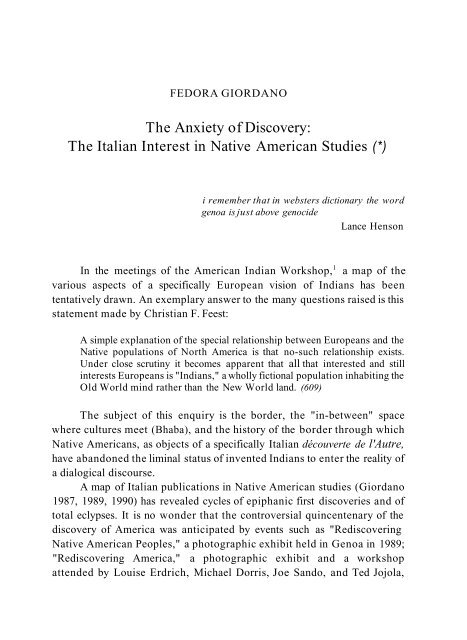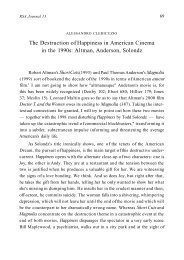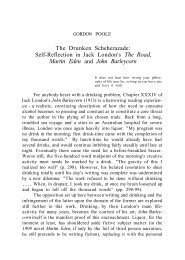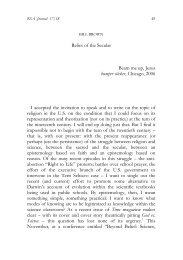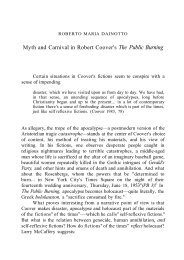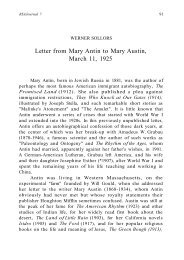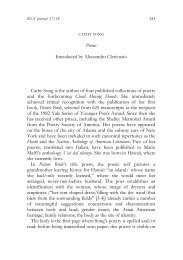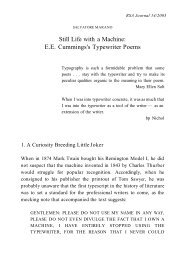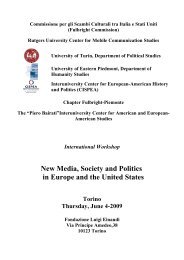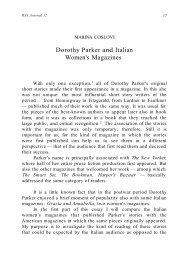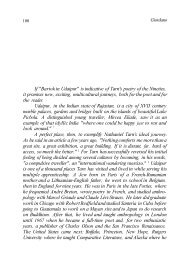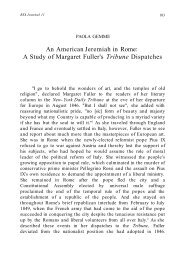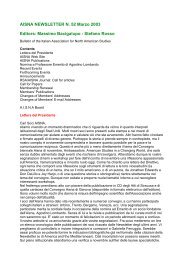The Anxiety of Discovery: The Italian Interest in Native ... - aisna
The Anxiety of Discovery: The Italian Interest in Native ... - aisna
The Anxiety of Discovery: The Italian Interest in Native ... - aisna
You also want an ePaper? Increase the reach of your titles
YUMPU automatically turns print PDFs into web optimized ePapers that Google loves.
FEDORA GIORDANO<br />
<strong>The</strong> <strong>Anxiety</strong> <strong>of</strong> <strong>Discovery</strong>:<br />
<strong>The</strong> <strong>Italian</strong> <strong>Interest</strong> <strong>in</strong> <strong>Native</strong> American Studies (*)<br />
i remember that <strong>in</strong> websters dictionary the word<br />
genoa is just above genocide<br />
Lance Henson<br />
In the meet<strong>in</strong>gs <strong>of</strong> the American Indian Workshop, 1 a map <strong>of</strong> the<br />
various aspects <strong>of</strong> a specifically European vision <strong>of</strong> Indians has been<br />
tentatively drawn. An exemplary answer to the many questions raised is this<br />
statement made by Christian F. Feest:<br />
A simple explanation <strong>of</strong> the special relationship between Europeans and the<br />
<strong>Native</strong> populations <strong>of</strong> North America is that no-such relationship exists.<br />
Under close scrut<strong>in</strong>y it becomes apparent that all that <strong>in</strong>terested and still<br />
<strong>in</strong>terests Europeans is "Indians," a wholly fictional population <strong>in</strong>habit<strong>in</strong>g the<br />
Old World m<strong>in</strong>d rather than the New World land. (609)<br />
<strong>The</strong> subject <strong>of</strong> this enquiry is the border, the "<strong>in</strong>-between" space<br />
where cultures meet (Bhaba), and the history <strong>of</strong> the border through which<br />
<strong>Native</strong> Americans, as objects <strong>of</strong> a specifically <strong>Italian</strong> découverte de l'Autre,<br />
have abandoned the lim<strong>in</strong>al status <strong>of</strong> <strong>in</strong>vented Indians to enter the reality <strong>of</strong><br />
a dialogical discourse.<br />
A map <strong>of</strong> <strong>Italian</strong> publications <strong>in</strong> <strong>Native</strong> American studies (Giordano<br />
1987, 1989, 1990) has revealed cycles <strong>of</strong> epiphanic first discoveries and <strong>of</strong><br />
total eclypses. It is no wonder that the controversial qu<strong>in</strong>centenary <strong>of</strong> the<br />
discovery <strong>of</strong> America was anticipated by events such as "Rediscover<strong>in</strong>g<br />
<strong>Native</strong> American Peoples," a photographic exhibit held <strong>in</strong> Genoa <strong>in</strong> 1989;<br />
"Rediscover<strong>in</strong>g America," a photographic exhibit and a workshop<br />
attended by Louise Erdrich, Michael Dorris, Joe Sando, and Ted Jojola,
82 Giordano<br />
held <strong>in</strong> Treviso <strong>in</strong> 1991; and "Discover<strong>in</strong>g American Indians," featur<strong>in</strong>g the<br />
American Indian Dance <strong>The</strong>atre, Robert Mirabal and Mud Ponies <strong>in</strong><br />
concert, and Jake Swamp, David Archambault, John Pretty on Top, and<br />
C<strong>in</strong>dy Kenny-Gilday <strong>in</strong> Rome <strong>in</strong> July 1992. <strong>The</strong>se can be seen as symptoms<br />
<strong>of</strong> a discovery anxiety <strong>in</strong> a country which has occupied an ambiguous<br />
position <strong>in</strong> the history <strong>of</strong> the colonization <strong>of</strong> America. <strong>The</strong> homeland <strong>of</strong><br />
explorers dramatically if <strong>in</strong>directly connected with the genocide <strong>of</strong> <strong>Native</strong><br />
American populations such as Christopher Columbus and Amerigo<br />
Vespucci, Italy has had no political or economic part <strong>in</strong> the colonization <strong>of</strong><br />
the American cont<strong>in</strong>ent and only a very m<strong>in</strong>or role <strong>in</strong> the <strong>in</strong>ternational<br />
colonial scene. On the other hand, as the homeland <strong>of</strong> the Holy See, Italy<br />
kept a constant l<strong>in</strong>k with the spiritual colonization <strong>of</strong> the <strong>Native</strong>s by the<br />
various orders <strong>of</strong> Roman Catholic missionaries. 3 Until the late n<strong>in</strong>eteenth<br />
century, when <strong>in</strong>formation on the <strong>Native</strong> peoples was eventually derived<br />
from American ethnological sources, the discourse on Indians was<br />
generally mediated by the philosophical and the missionary colonial<br />
discourse. It was from Rome that <strong>in</strong> 1537 the Pope discovered, or declared,<br />
the humanity <strong>of</strong> the Indians "quia veri hom<strong>in</strong>es quia fidei catholicae et<br />
sacramentorum capaces" (Di Nola). <strong>The</strong> Collegium De Propaganda Fide<br />
was founded <strong>in</strong> Rome by Pope Gregory XV <strong>in</strong> 1622 with the aim <strong>of</strong><br />
coord<strong>in</strong>at<strong>in</strong>g the work <strong>of</strong> the various Roman Catholic orders <strong>in</strong> the<br />
American missions. Its archives, together with those <strong>of</strong> the Archivum<br />
Romanum Societatis Jesu, conta<strong>in</strong> the missionaries' detailed reports to their<br />
superiors, a wealth <strong>of</strong> <strong>in</strong>formation that is still be<strong>in</strong>g explored (Codignola,<br />
Pizzorusso 1990). Yet it was the Spanish Franciscan and Jesuit Padres, the<br />
French Capuch<strong>in</strong>s, Jesuits, Recollets, and Sulpicians, together with<br />
Portuguese missionaries, who played the major role <strong>in</strong> the colonization.<br />
Only a small number <strong>of</strong> Jesuits were sent to the Spanish colonies <strong>in</strong> the<br />
sixteenth century from the K<strong>in</strong>gdom <strong>of</strong> Naples, a Spanish viceroyalty, and<br />
from the seventeenth century onwards to the French colonies from the<br />
various states <strong>in</strong> which Italy was divided (Pizzorusso 1992, 18). Among<br />
these missionaries, the Jesuits Bressani and K<strong>in</strong>o are certa<strong>in</strong>ly worth<br />
mention<strong>in</strong>g here as particularly relevant to our <strong>in</strong>vestigation. Francesco<br />
Giuseppe Bressani, from Rome, was the first <strong>Italian</strong> to jo<strong>in</strong> the French<br />
missionaries <strong>in</strong> New France. His Breve Relatione (1653) on the failure <strong>of</strong> the<br />
mission <strong>of</strong> Sa<strong>in</strong>te-Marie-des-Hurons is the first published document <strong>in</strong><br />
<strong>Italian</strong> on the New France missions. <strong>The</strong> report also <strong>in</strong>cludes letters on his
RSA Journal 5<br />
captivity and torture at the hands <strong>of</strong> the Iroquois and translations <strong>of</strong><br />
excerpts from the Relations des Jésuites. In describ<strong>in</strong>g the land and customs<br />
<strong>of</strong> the Hurons and the Algonqu<strong>in</strong>s, Bressani, although he uses such epithets<br />
as "Barbarians" and "unfaithful," displays a keen faculty <strong>of</strong> observation. In<br />
their dress<strong>in</strong>g, Algonqu<strong>in</strong> women are modest—much more so, <strong>in</strong> fact, than<br />
"the most religious women <strong>in</strong> Europe" (9). <strong>The</strong> Hurons are utterly<br />
democratic and egalitarian. <strong>The</strong>y reckon time by the moons, like the<br />
Hebrews. <strong>The</strong>y lack "religion," i.e. organized worship with priests, temples,<br />
and rituals, but believe <strong>in</strong> the soul's immortality and <strong>in</strong> the existence <strong>of</strong> a<br />
Supreme Be<strong>in</strong>g:<br />
their sentiments are widely diverg<strong>in</strong>g from those <strong>of</strong> our freeth<strong>in</strong>kers and<br />
from those <strong>of</strong> the atheists. First, they believe <strong>in</strong> the immortality <strong>of</strong> the soul<br />
and <strong>in</strong> the existence <strong>of</strong> two separate homes <strong>in</strong> the West, one for the happy<br />
and one for the wretched; but these ideas are muddled with countless tales<br />
<strong>in</strong> the way the ancients did when speak<strong>in</strong>g <strong>of</strong> their Elysian Fields. Second,<br />
they believe <strong>in</strong> good and <strong>in</strong> malevolent spirits ... and they certa<strong>in</strong>ly have both<br />
the sense <strong>of</strong> a div<strong>in</strong>e be<strong>in</strong>g and <strong>of</strong> his name, which they <strong>in</strong>voke <strong>in</strong> times <strong>of</strong><br />
danger, although they ignore its true mean<strong>in</strong>g (19).<br />
<strong>The</strong>ir languages show the presence <strong>of</strong> God <strong>in</strong> their souls, for they are "most<br />
beautiful and regular" and their structure "surpasses that <strong>of</strong> all European<br />
languages that we know" (Clements 52).<br />
<strong>The</strong> description <strong>of</strong> Indian cultures was a methodological stage typical<br />
<strong>of</strong> the Jesuit missionary approach—an approach which today is <strong>of</strong>ten seen<br />
as an objective "post mortem" (Catalano), follow<strong>in</strong>g the disappearance <strong>of</strong><br />
the traditions observed, s<strong>in</strong>ce the frontier between cultures was considered<br />
"an obstacle to be surmounted, a goal to be reached and overcome"<br />
(Calarco 27). This is the conception <strong>of</strong> frontier which was shared by Father<br />
K<strong>in</strong>o, Eugenio Francesco Ch<strong>in</strong>i from Segno, Trento (1645-1711), who was<br />
sent to Mexico, Arizona, and Baja California <strong>in</strong> 1681. A mathematician,<br />
astronomer, geographer, and explorer, he drew the first maps <strong>of</strong> the Sonora<br />
desert, discovered Baja California to be a pen<strong>in</strong>sula, and <strong>in</strong>troduced cattle<br />
ranch<strong>in</strong>g among the <strong>Native</strong>s. A missionary among the Pima-Papagos, the<br />
Yumas, the Gilas, the Cocoma-Maricopas, he aknowledged and defended<br />
the civil rights <strong>of</strong> the converts. His benevolent attitude is typical <strong>of</strong> the<br />
spiritual colonizer, for whom the discovery is a one-sided, transitional stage<br />
<strong>in</strong> the progress <strong>of</strong> Christianity. In his autobiography (Favores Celestiales,<br />
83
84 Giordano<br />
1699-1710) and <strong>in</strong> his reports, Father K<strong>in</strong>o describes the land more than the<br />
people, who are considered simply from the po<strong>in</strong>t <strong>of</strong> view <strong>of</strong> a good<br />
Shepherd: the Pimas, like the California Indians, are "docile, extremely<br />
friendly, affable, and unafraid." <strong>The</strong>se sun worshippers do not have a<br />
doctr<strong>in</strong>e nor idols, nor spiritual leaders like <strong>in</strong> Japan or <strong>in</strong> Ch<strong>in</strong>a; therefore,<br />
it is easy to <strong>in</strong>stil <strong>in</strong> them the idea <strong>of</strong> God, the Creator <strong>of</strong> the universe<br />
(Bolton 2, 270).<br />
Until the end <strong>of</strong> the eighteenth century, however, the missionaries'<br />
somewhat realistic reports had very little impact on the discourse on<br />
Indians outside <strong>of</strong> the Church. In the f<strong>in</strong>e arts, the <strong>Native</strong>s were not<br />
discovered so much as <strong>in</strong>vented follow<strong>in</strong>g the changes <strong>in</strong> the colonial<br />
discourse. As the <strong>in</strong>terest <strong>of</strong> seventeenth century <strong>in</strong>tellectuals seemed to be<br />
concentrated on admiration <strong>of</strong> the complex culture and political<br />
organization <strong>of</strong> the Aztecs and Incas (Zanovello 132) and to relegate most<br />
North American Indians to the role <strong>of</strong> barbarians and savages, artists saw<br />
the Indians primarily as objects <strong>of</strong> allegorical representation. <strong>The</strong> nude girl<br />
bedecked with feathers and armed with bow and arrow <strong>in</strong> Cesare Mar<strong>in</strong>o's<br />
<strong>in</strong>fluential Iconologia (1603) was used "by practically every Baroque artist"<br />
(Honour 131) as an image <strong>of</strong> America. In the eighteenth century, the artistic<br />
canons <strong>of</strong> Oriental exoticism began to be applied to America. Even the<br />
more realistic scenes <strong>of</strong> Indian customs and war scenes pa<strong>in</strong>ted on the walls<br />
<strong>of</strong> <strong>Italian</strong> "Indian parlours"—such as the one <strong>in</strong> Palazzo Barber<strong>in</strong>i <strong>in</strong><br />
Rome—were projected <strong>in</strong>to an Edenic world <strong>of</strong> exotic flowers and animals<br />
(Giordano 1989).<br />
By the mid-1760s, all the Jesuits had been expelled from both North<br />
and South America. Many refugees came to Italy where they shared their<br />
knowledge <strong>of</strong> Indian languages and cultures, expla<strong>in</strong><strong>in</strong>g the <strong>in</strong>nocence <strong>of</strong><br />
the "Savages" with their lack <strong>of</strong> private property and their convent-like<br />
community organization. Antonello Gerbi's La disputa del Nuovo Mondo<br />
<strong>of</strong>fers a critical survey <strong>of</strong> the eighteenth-century <strong>Italian</strong> debate on the<br />
"Savages <strong>of</strong> America," which centered on Cornelius de Pauw's Recherches<br />
Philosophiques sur les América<strong>in</strong>s (1768), on the physical and moral<br />
<strong>in</strong>feriority <strong>of</strong> the <strong>Native</strong> Americans, on the Burkes Account <strong>of</strong> the European<br />
Settlement <strong>of</strong> America (translated 1763), and on missionary texts.<br />
Count Gian R<strong>in</strong>aldo Carli from Capodistria (1720-1795), a m<strong>in</strong>ister<br />
<strong>of</strong> the Duchy <strong>of</strong> Milan, dismissed rather simplistically the theories <strong>of</strong> both<br />
Rousseau and de Pauw, and <strong>of</strong>fered <strong>in</strong> opposition to America's Savages
RSA Journal 5<br />
("We know there are savages also <strong>in</strong> Europe and <strong>in</strong> Africa") the highly<br />
civilized Mayas and Incas. He exalted the Incaic government as "the most<br />
regular and paternal <strong>of</strong> all empires <strong>in</strong> the world at all times" (Gerbi 258),<br />
ma<strong>in</strong>ta<strong>in</strong><strong>in</strong>g that "the rul<strong>in</strong>g pr<strong>in</strong>ciple <strong>of</strong> the governors was to impose<br />
happ<strong>in</strong>ess on their subjects" (259). His very successful Lettere Americane<br />
(1780) were also based on <strong>in</strong>formation directly obta<strong>in</strong>ed from a Peruvian<br />
Jesuit. Carli's discovery was <strong>of</strong> the common derivation <strong>of</strong> all <strong>Native</strong><br />
American civilizations from Egypt and the Mediterranean civilization. This<br />
was an antecedent <strong>of</strong>the theory <strong>of</strong> the Egyptian orig<strong>in</strong>s <strong>of</strong> civilization which<br />
was later elaborated by the English scholars C. G. Elliot Smith and W. J.<br />
Perry at the beg<strong>in</strong>n<strong>in</strong>g <strong>of</strong> the twentieth century (Sestan 142). In the context<br />
<strong>of</strong> the debate on Vico, Gian Francesco F<strong>in</strong>etti published a treaty In Difesa<br />
dell' autorità delle Sacre Scritture contro Giovan Battista Vico (1768) <strong>in</strong><br />
which he showed an illum<strong>in</strong>ated understand<strong>in</strong>g <strong>of</strong> primitive ritual:<br />
it seems clear that, <strong>in</strong>stead <strong>of</strong> be<strong>in</strong>g caused by stupid superstition and<br />
monstruous cruelty, the use <strong>of</strong> human victims was the result <strong>of</strong> a false<br />
ref<strong>in</strong>ement <strong>of</strong> reason, ow<strong>in</strong>g to which man believed that sacrifices were all<br />
the more welcome to God when the victims were more precious. (Zolla 174<br />
75)<br />
It was <strong>in</strong> Italy that the Mexican Jesuit Francisco Clavijero wrote his<br />
<strong>in</strong>fluential Storia Antica del Messico (1780-81) dedicated to Count Carli, <strong>in</strong><br />
which he rejected de Pauw's theories, and his Storia della California (1789).<br />
A famous scholar <strong>of</strong> <strong>Native</strong> languages and the head <strong>of</strong> Propaganda Fide,<br />
Card<strong>in</strong>al Giuseppe Mezz<strong>of</strong>anti learned the Nahuatl language from<br />
Clavijero's manuscripts as part <strong>of</strong> his project to translate Catholic prayers.<br />
At the beg<strong>in</strong>n<strong>in</strong>g <strong>of</strong> the n<strong>in</strong>eteenth century <strong>Native</strong> Americans were<br />
admitted to the College <strong>of</strong> Propaganda, and <strong>in</strong> 1834 two young men from<br />
the mission <strong>of</strong> San Luis Rey, Paolo Tac and Agapito Amamix, taught<br />
Luiseño to Mezz<strong>of</strong>anti (Laurencich M<strong>in</strong>elli). <strong>The</strong> dream <strong>of</strong> a <strong>Native</strong><br />
American Catholic state came to a tragic end <strong>in</strong> 1832 when William<br />
Blackbird, an Ottawa, was assass<strong>in</strong>ated at the Pontifical College <strong>in</strong> Rome<br />
where he was to be orda<strong>in</strong>ed priest. He had been appo<strong>in</strong>ted by his tribe to<br />
negotiate with President Jackson that Michigan become an Indian state <strong>in</strong><br />
order to halt the advance <strong>of</strong> whites (Zolla 102, Feest 616).<br />
Giacomo Leopardi, one <strong>of</strong> whose tutors was the Mexican Jesuit<br />
85
86 Giordano<br />
Giuseppe Torres, read Clavijero, Carli, and Robertson <strong>in</strong> the 1780<br />
translation. He entered the debate on savagism and civilization <strong>in</strong> his<br />
philosophical notebook Zibaldone, dist<strong>in</strong>guish<strong>in</strong>g between "Savages," who<br />
lived <strong>in</strong>nocently <strong>in</strong> a natural state, and "Barbarians," who knew some sort<br />
<strong>of</strong> civilization. <strong>The</strong> California Indians, considered the people furthest<br />
removed from civilization, ignor<strong>in</strong>g language and society (Sozzi 207, Gerbi<br />
428), became the noble savages, "beata prole" <strong>of</strong> the "Californie selve" <strong>in</strong><br />
his poem Inno ai Patriarchi (Sozzi, Giordano 1989).<br />
Accidental Discoveries<br />
Although the library rema<strong>in</strong>ed the privileged space for the <strong>Italian</strong><br />
discourse on Indians, from the period <strong>of</strong> the American Revolution, when<br />
Frankl<strong>in</strong> and Jefferson enterta<strong>in</strong>ed relations with <strong>Italian</strong> <strong>in</strong>tellectuals<br />
(Massara 1976), certa<strong>in</strong> <strong>Italian</strong> travellers became, <strong>in</strong> Fiorent<strong>in</strong>o's<br />
appropriate def<strong>in</strong>ition, also "accidental ethnographers." <strong>The</strong>ir unprepared<br />
discoveries, however, were conditioned by the ideological limitations <strong>of</strong><br />
European Enlightenment, which, notwithstand<strong>in</strong>g its cosmopolitanism,<br />
saw only Noble and Ignoble Savages. Such was the case <strong>of</strong> the Bolognese<br />
geologist Giovanni Capell<strong>in</strong>i (1833-1892), a friend <strong>of</strong> Louis Agassiz<br />
(Massara 1976) who met the Omahas and Poncas <strong>in</strong> 1863 (Fiorent<strong>in</strong>o<br />
1993). <strong>The</strong> same can be said <strong>of</strong> the notes on Northwest Coast tribes left by<br />
the <strong>Italian</strong> cartographer and Spanish Navy <strong>of</strong>ficer Alessandro Malasp<strong>in</strong>a<br />
(1754-1810; Fiorent<strong>in</strong>o 1993), as well as <strong>of</strong> the work <strong>of</strong> Giacomo<br />
Costant<strong>in</strong>o Beltrami (1779-1855) whose adventures allegedly <strong>in</strong>spired both<br />
James Fenimore Cooper and Chateaubriand (Massara 1976, 18). This<br />
accidental discoverer <strong>of</strong> the sources <strong>of</strong> the Mississippi river (1823) collected<br />
a considerable amount <strong>of</strong> pipes, weapons, shields, and other objects <strong>of</strong><br />
remarkable <strong>in</strong>terest which now form the core collection <strong>of</strong> a small museum<br />
<strong>in</strong> Bergamo (Fiorent<strong>in</strong>o 1990, 1993). In his writ<strong>in</strong>gs on his botanical<br />
expeditions <strong>of</strong> 1785-1787, Count Luigi Castiglioni (1757-1832) <strong>of</strong> the école<br />
de Milan (Marenco), an honorary member <strong>of</strong> the American Philosophical<br />
Society, projected onto the Penobscot and Choctaw Indians the image <strong>of</strong><br />
the Noble Savage and attributed to the colonists the moral lassitude<br />
traditionally attributed to the Indians (Gerbi 300, Fiorent<strong>in</strong>o 1993, 88).
RSA Journal 5<br />
Indians on Stage and Indian Galleries<br />
<strong>The</strong> philosophical debate on the conflict between savagism and<br />
civilization was reflected <strong>in</strong> <strong>Italian</strong> theatre from the middle <strong>of</strong> the<br />
eighteenth century (Del Negro, Massara 1984), when, follow<strong>in</strong>g the great<br />
success <strong>of</strong> Alzire (1736), Voltaire's tragedy on the conquest <strong>of</strong> Peru, and <strong>of</strong><br />
Madame de Grafigny's Lettres d'une Peruvienne (1747), Carlo Goldoni<br />
produced two comedies <strong>of</strong> crossed love between imag<strong>in</strong>ary Indians and<br />
Frenchmen. <strong>The</strong>se were La Peruviana (1754), which br<strong>in</strong>gs an Indian<br />
pr<strong>in</strong>cess to a Paris salon and to Christianity, and the tragicomedy La bella<br />
selvaggia (1758), set <strong>in</strong> Guyana among Indians whose natural virtues are<br />
those <strong>of</strong> the Venitian bourgeois class <strong>of</strong> Goldoni's times. With respect to the<br />
very popular <strong>Italian</strong> genre <strong>of</strong> melodrama, among many works on Columbus,<br />
on the discovery <strong>of</strong> America, and on the conquest <strong>of</strong> Mexico, several operas<br />
had Indians as protagonists. <strong>The</strong> opéra comique L'Americano (1772), for<br />
which Niccolò Picc<strong>in</strong>ni wrote the music (Massara 1984, 31), recounted the<br />
adventures <strong>of</strong> a California Indian <strong>in</strong> Italy. Gli Ill<strong>in</strong>esi (1819, rev. 1836), an<br />
opera by Felice Romani with music by Antonio Coppola, was set among the<br />
Ill<strong>in</strong>ois. Here the Frenchman Guido is fight<strong>in</strong>g his former companions for<br />
love <strong>of</strong> Irza, orphaned daughter <strong>of</strong> an Ill<strong>in</strong>ois chief. This impossible love,<br />
contrasted both by Guido's father and by the Ill<strong>in</strong>ois tribe, f<strong>in</strong>ds its<br />
realization with the promise <strong>of</strong> Irza's conversion to her suitor's God.<br />
<strong>The</strong> stage, at the other extreme from the scholar's cab<strong>in</strong>et, was the<br />
only space where Indians entered the popular sphere s<strong>in</strong>ce the public<br />
exhibitions <strong>of</strong> Indians, not uncommon <strong>in</strong> European cities (Feest), were<br />
almost unknown <strong>in</strong> Italy except for a few <strong>in</strong>stances. In 1828, three Osage<br />
men had been "<strong>in</strong>troduced" to K<strong>in</strong>g Carlo Felice and Pr<strong>in</strong>ce Carlo Alberto<br />
<strong>of</strong> Savoy (Ciliento 54). <strong>The</strong> same year, an Eskimo woman from Greenland,<br />
probably acquired <strong>in</strong> France, was exhibited <strong>in</strong> Northern <strong>Italian</strong> towns and<br />
cities by a V<strong>in</strong>cenzo Pagan<strong>in</strong>i (Zavatti). Towards the end <strong>of</strong> the n<strong>in</strong>eteenth<br />
century, the Church was a more pious exhibitor, this time <strong>of</strong> <strong>in</strong>vented happy<br />
converts at the 1892 Genoa quadricentennial Italo-American Exposition<br />
(Clerici 1990).<br />
In February 1840, George Catl<strong>in</strong> began <strong>in</strong> Piccadilly, London, the<br />
European tour <strong>of</strong> his "Indian gallery" <strong>of</strong> 507 pa<strong>in</strong>t<strong>in</strong>gs and draw<strong>in</strong>gs <strong>of</strong><br />
American Indian life that toured England, France, and Belgium for eight<br />
years with the accompaniment <strong>of</strong> tableaux vivants staged by fake as well<br />
87
88 Giordano<br />
as by real Indians (Mulvey). <strong>Italian</strong>s could only read an excerpt from<br />
Catl<strong>in</strong>'s letters published <strong>in</strong> 1869 (Solimano 107). A smaller but<br />
artistically relevant neo-classical "Indian Gallery" <strong>of</strong> four bas-reliefs, four<br />
full-size statues, fourteen busts and eight studies <strong>in</strong> terra-cotta pa<strong>in</strong>ted<br />
limestone was brought to Rome <strong>in</strong> 1858 by the Dresden sculptor<br />
Ferd<strong>in</strong>and Pettrich, a gifted pupil <strong>of</strong> Bertel Thorwaldsen who had<br />
worked for several years <strong>in</strong> Wash<strong>in</strong>gton (A. Mariani). <strong>The</strong> bas-reliefs<br />
represented a buffalo hunt<strong>in</strong>g scene, a war dance, a battle between<br />
W<strong>in</strong>nebago and Cree, and the Wash<strong>in</strong>gton Council <strong>of</strong> 1837. 4 Among the<br />
statues were those <strong>of</strong> famous warriors: full-size portraits <strong>of</strong> the dy<strong>in</strong>g<br />
Tecumseh and <strong>of</strong> Sioux Chief Pour<strong>in</strong>g Hurricane, and the busts <strong>of</strong> Black<br />
Hawk and Roar<strong>in</strong>g Thunder <strong>of</strong> the Sauk and Foxes. Pettrich donated all<br />
his sculptures to Pope Pius IX and they were exhibited <strong>in</strong> the Lateran<br />
Palace (Giordano 1989). Admired as a work <strong>of</strong> art, the "Portrait Gallery<br />
<strong>of</strong> the Savages" became the object <strong>of</strong> learned discussions. In an essay<br />
written <strong>in</strong> 1859 Antonio Bresciani, the Jesuit director <strong>of</strong> the Collegium De<br />
Propaganda Fide, studied the Caucasian facial features <strong>in</strong> the statues and<br />
thus gave support to Humbolt's and Clavijero's theories on the<br />
colonization <strong>of</strong> Yucatan by the Phoenicians and <strong>of</strong> the Northern orig<strong>in</strong>s<br />
<strong>of</strong> Toltecs and Aztecs. Struck by the beauty and realism <strong>of</strong> the portraits,<br />
Bresciani saw them as the means by which Pettrich had enabled those<br />
distant "children <strong>of</strong> the forests" to cross the ocean <strong>in</strong> effigy and venerate<br />
Christ's Vicar (Bresciani 546).<br />
At the turn <strong>of</strong> the century, the <strong>Italian</strong> press <strong>of</strong>fered the image <strong>of</strong> the<br />
vanish<strong>in</strong>g American (Ciliento, Solimano) precisely at the time when <strong>Native</strong><br />
Americans started com<strong>in</strong>g to Italy not as objects <strong>of</strong> study for selected<br />
scholars—as had been Paolo Tac and Agapito Amamix or the Pettrich<br />
statues—but as <strong>in</strong>voluntary agents <strong>of</strong> a new <strong>in</strong>vention: as actors <strong>in</strong> the Wild<br />
West Show, which toured Europe between 1887 and 1906. Preceeded by<br />
the press reports <strong>of</strong> their success <strong>in</strong> England, France and Spa<strong>in</strong>, Buffalo<br />
Bill's Indians arrived <strong>in</strong> Naples <strong>in</strong> February 1890. Some <strong>of</strong> them had come<br />
to Europe on a journey <strong>of</strong> discovery and knowledge, like young Black Elk,<br />
who was later to tell John Neihardt <strong>of</strong> his expectations:<br />
Maybe if I could see the great world <strong>of</strong> the Wasichu, I could understand how<br />
to br<strong>in</strong>g the sacred hoop together and make the tree bloom aga<strong>in</strong> at the<br />
center <strong>of</strong> the world. (Neihardt 183)
RSA Journal 5<br />
However, no similar attitude was to be found <strong>in</strong> the culturally<br />
unprepared <strong>Italian</strong> public. Black Elk went back to P<strong>in</strong>e Ridge <strong>in</strong> 1889. <strong>The</strong><br />
rest <strong>of</strong> the troupe, largely Sioux (Napier), held shows <strong>in</strong> Naples, Rome,<br />
Verona, Venice, Genoa, Bologna, and Milan. <strong>The</strong> American <strong>Native</strong>s were<br />
more impressed by <strong>Italian</strong> landscape and nature, especially by Mount<br />
Vesuvius, than by <strong>Italian</strong>s. <strong>The</strong> public seemed to love Buffalo Bill but<br />
looked skeptically at the Indians and at the cowboys' feats, and challenged<br />
them to a rodeo with butteri from the wild pasture lands <strong>of</strong> Cisterna. After<br />
the show people flocked backstage to the arena where tents were pitched,<br />
to see the Indians' supposedly real everyday life. Among them was the<br />
Roman Count Giuseppe Primoli, who took very realistic photographs <strong>of</strong><br />
actors and spectators after a performance <strong>in</strong> Rome, <strong>in</strong> the Monte Mario<br />
area, <strong>in</strong> March 1890 (Fulgenzi). Pope Leo XIII <strong>in</strong>vited the troupe to the<br />
celebrations for his eleventh anniversary as pontiff. Ironically, after many<br />
reporters had been most impressed by the colorful body pa<strong>in</strong>t<strong>in</strong>gs and<br />
costumes <strong>of</strong> the Indians (Fiorent<strong>in</strong>o 1987), the Indians <strong>in</strong> turn were<br />
impressed by the magnificent procession. <strong>The</strong> Swiss guards <strong>in</strong> their<br />
medieval costumes and the card<strong>in</strong>als and archbishops follow<strong>in</strong>g the Papal<br />
Throne through the Sist<strong>in</strong>e Chapel <strong>in</strong> golden embroidered robes <strong>of</strong> white<br />
and purple silk struck the Indians more than "the great medic<strong>in</strong>e man sent<br />
by the Great Spirit" whose power had not prevented the death <strong>of</strong> one <strong>of</strong><br />
their comrades (Napier 399). By the time <strong>of</strong> their second <strong>Italian</strong> tour <strong>in</strong><br />
1906 and their last show <strong>in</strong> La Spezia, they were desperate to leave. <strong>The</strong><br />
man who played Sitt<strong>in</strong>g Bull, fed up with always play<strong>in</strong>g the loser, went on<br />
a dr<strong>in</strong>k<strong>in</strong>g b<strong>in</strong>ge and got lost on his way home (Clerici 1987, 423).<br />
Discover<strong>in</strong>g <strong>Native</strong> American Literatures<br />
<strong>The</strong> Romantic revision <strong>of</strong> the far past, br<strong>in</strong>g<strong>in</strong>g <strong>in</strong>to focus folk life and<br />
traditions, led to the rediscovery <strong>of</strong> the ancient bards and oral poetry. From<br />
this border arose a new discourse on oral literatures which <strong>in</strong>cluded <strong>Native</strong><br />
American cultures. Among the <strong>Italian</strong> <strong>in</strong>tellectuals who engaged <strong>in</strong> the<br />
trascription <strong>of</strong> regional dialects and oral poetry, the most <strong>in</strong>fluential<br />
was Giuseppe Pitré (1841-1916), the Sicilian physician, historian, and<br />
philologist who, with his life-long project, the Biblioteca di tradizioni<br />
popolari siciliane (1871-1913), was the founder <strong>of</strong> the <strong>Italian</strong> school <strong>of</strong><br />
89
90 Giordano<br />
folklore. From Pitré's circle came a translator <strong>of</strong> <strong>Native</strong> American songs,<br />
Girolamo Ragusa Moleti (1851-1917), Pr<strong>of</strong>essor <strong>of</strong> Aesthetics at the<br />
University <strong>of</strong> Palermo. An early translator <strong>of</strong> Walt Whitman, <strong>in</strong> 1891 he<br />
published an anthology <strong>of</strong> primitive songs from all over the world, Poesie<br />
dei popoli selvaggi 0 poco civili. <strong>Interest</strong>ed <strong>in</strong> the history <strong>of</strong> literary genres,<br />
Ragusa Moleti espoused van Gennep's theory put forth <strong>in</strong> La formation des<br />
legendes and saw the orig<strong>in</strong>s <strong>of</strong> modern poetry <strong>in</strong> primitive forms. His<br />
anthology was an attempt to give a panoramic view <strong>of</strong> oral literatures from<br />
all over the world, from Africa to Lapland, <strong>Native</strong> America, Afro-America,<br />
Asia, and Oceania. In the Appendix, he <strong>in</strong>cluded a full translation <strong>of</strong> the<br />
Quechua epic Ollontay. Although questionable for its simplified "life and<br />
customs" approach, Ragusa Moleti's choice <strong>of</strong> genres is <strong>in</strong>terest<strong>in</strong>g as it<br />
<strong>in</strong>cludes lullabies, mourn<strong>in</strong>g songs, religious songs, war songs, work songs,<br />
slave songs, songs <strong>in</strong> favor or <strong>in</strong> hate <strong>of</strong> white people, satirical songs, love<br />
songs, wedd<strong>in</strong>g songs, animal songs, epic songs, and miscellaneous songs.<br />
Evolutionary anthropologists—mostly <strong>in</strong> physical anthropology—<br />
were also marg<strong>in</strong>ally <strong>in</strong>terested <strong>in</strong> <strong>Native</strong> American oral literatures. At the<br />
beg<strong>in</strong>n<strong>in</strong>g <strong>of</strong> the twentieth century, for reasons connected with the<br />
development <strong>of</strong> <strong>Italian</strong> ethnology, oral poetry was still a privileged field <strong>of</strong><br />
research (Cocchiara). A survey <strong>of</strong> oral literatures was published by the<br />
pathologist Paolo Mantegazza (1831-1910), holder <strong>of</strong> the first <strong>Italian</strong> chair<br />
<strong>of</strong> physical anthropology, created at the University <strong>of</strong> Florence <strong>in</strong> 1869.<br />
Mantegazza had "discovered" Indians <strong>in</strong> northwestern Argent<strong>in</strong>a and<br />
published an anthropological study <strong>of</strong> primitive love customs. He was also<br />
the founder <strong>of</strong> the anthropological-ethnographic museum <strong>in</strong> Florence,<br />
where he displayed items donated by other travellers.<br />
A zoologist, Enrico Hillyer Giglioli (1845-1909), was also <strong>in</strong>volved <strong>in</strong><br />
the activities <strong>of</strong> the Florence School <strong>of</strong> Anthropology. He travelled around<br />
the world on a naturalists' expedition (1865-1868) and from 1883 became<br />
an <strong>in</strong>ternationally-known collector <strong>of</strong> archaeological and ethnographical<br />
material, which he also exchanged with experts <strong>of</strong> the Smithsonian<br />
Institution. His huge collection <strong>in</strong>cluded several hundred artifacts and two<br />
thousand archaeological items from North America, and more than a<br />
hundred photographs <strong>of</strong> <strong>Native</strong> Americans by Hillers, O'Sullivan, and Bell.<br />
After his death, Giglioli's collection, together with his archaeological and<br />
ethnological library, went to form the ethnological core <strong>of</strong> the National<br />
Museum <strong>of</strong> Prehistory founded <strong>in</strong> Rome by Luigi Pigor<strong>in</strong>i <strong>in</strong> 1876 (Tiber<strong>in</strong>i).
RSA Journal 5<br />
Carlo Cattaneo (1801-1859) is considered by some scholars (Tullio<br />
Altan) to be the <strong>Italian</strong> <strong>in</strong>itiator <strong>of</strong> Cultural Anthropology and Social<br />
Psychology because he was responsible for <strong>in</strong>clud<strong>in</strong>g <strong>in</strong> the curriculum <strong>of</strong><br />
philosophical studies at the Lugano Lyceum topics such as Cosmology,<br />
Ethnography, Individual and Social Ideology, and L<strong>in</strong>guistics. Yet his<br />
perception <strong>of</strong> America's <strong>Native</strong>s was conditioned by the concept <strong>of</strong> the<br />
Ignoble Savage which he had found <strong>in</strong> W. Robertson's History <strong>of</strong>America<br />
(Scuderi).<br />
Giuseppe Sergi (1841-1936), Pr<strong>of</strong>essor <strong>of</strong> Physical Anthropology at<br />
the University <strong>of</strong> Rome, founder <strong>of</strong> its anthropological museum and, after<br />
his break with Paolo Mantegazza, <strong>of</strong> the Societa Romana di Antropologia<br />
(1893), published several essays on American anthropology based on the<br />
publications <strong>of</strong> the Bureau <strong>of</strong> American Ethnology, before concentrat<strong>in</strong>g<br />
his research on the study <strong>of</strong> skulls. In his essay "Costumi funerari degli<br />
Indiani d'America" (1883) he compared <strong>Native</strong> American burial rituals<br />
with those revealed by archaeological f<strong>in</strong>d<strong>in</strong>gs <strong>in</strong> Italy, po<strong>in</strong>t<strong>in</strong>g to a<br />
similarity between Indian and Mediterranean animal sacrifices and pa<strong>in</strong>t<strong>in</strong>g<br />
<strong>of</strong> the face <strong>of</strong> the dead. Moreover, he compared Indian death ceremonies to<br />
those <strong>of</strong> the ancient Greeks. Patroclus' funeral, described by Homer <strong>in</strong> the<br />
Iliad, is quoted by Sergi as a def<strong>in</strong>itive demonstration <strong>of</strong> the aff<strong>in</strong>ity<br />
between distant cultures at the "half-savage" stage <strong>of</strong> their development.<br />
<strong>The</strong> scholar's observations display certa<strong>in</strong> similarities to those theories<br />
which saw the orig<strong>in</strong> <strong>of</strong> religion <strong>in</strong> fear:<br />
we can discover <strong>in</strong> the funerary customs <strong>of</strong> various peoples the primitive<br />
knowledge <strong>of</strong> various races on the orig<strong>in</strong>s and dest<strong>in</strong>y <strong>of</strong> man, and on his<br />
relations with nature and with the higher be<strong>in</strong>gs created by his fantasy under<br />
the <strong>in</strong>fluence <strong>of</strong> fear and ignorance. Through different funerary customs we<br />
can penetrate the curious and frightened soul <strong>of</strong> the poor savage ... (Sergi<br />
1883, 464; my translation.)<br />
Paleoethnology is a safe cultural frontier, while the discovery is that<br />
<strong>of</strong> a doomed race:<br />
I shall take the reader to America among the Indians, scattered over an<br />
immense territory, but now dim<strong>in</strong>ish<strong>in</strong>g and on their way to vanish<strong>in</strong>g<br />
because <strong>of</strong> the colonizers from the old world. (465)<br />
91
92 Giordano<br />
Sergi's <strong>in</strong>terest <strong>in</strong> <strong>Native</strong> American physical anthropology cont<strong>in</strong>ued<br />
for many years. Almost forty years after his first essay, he wrote <strong>of</strong> the<br />
importance <strong>of</strong> the morphological study <strong>of</strong> skulls as a pro<strong>of</strong> <strong>of</strong> the Asian<br />
orig<strong>in</strong>s <strong>of</strong> America's <strong>Native</strong>s (1928).<br />
At the 6th congress <strong>of</strong> the Société des Américanistes, <strong>in</strong> Tur<strong>in</strong> <strong>in</strong> 1886,<br />
V<strong>in</strong>cenzo Grossi, lecturer <strong>in</strong> American Ethnology at the University <strong>of</strong><br />
Genoa, read a paper on L<strong>in</strong>gue, letteratura e tradizioni popolari degli<br />
Indigeni d'America. His survey <strong>of</strong> the various l<strong>in</strong>guistic groups was based on<br />
the works <strong>of</strong> Friederich Müller and Daniel Br<strong>in</strong>ton. <strong>Native</strong> American<br />
literature was represented by an excerpt from <strong>The</strong> Red Swan translated by<br />
Ferd<strong>in</strong>ando Borsari, by an Iroquois tale ("<strong>The</strong> Thunder-Makers"), and by<br />
a Blackfoot tale ("<strong>The</strong> Story <strong>of</strong> the Three Lovers") translated from the<br />
French versions, respectively, <strong>of</strong> V. Henry and Emile Petitot. Grossi's essay<br />
presented literature classified as "Eskimo" and "Red-Sk<strong>in</strong>" (pellirossa is<br />
unfortunately still <strong>in</strong> use today), Mexican and Central American, Peruvian<br />
and Brazilian, and showed a good knowledge <strong>of</strong> the reports <strong>of</strong> the Bureau<br />
<strong>of</strong> American Ethnology. A shorter study, Tra i Pelli-Rosse d'America,<br />
concentrated on ethnographical "curios" and gave a short account <strong>of</strong><br />
funerary rituals, orators, and poets.<br />
In 1888, at about the time when American ethnologists started<br />
acknowledg<strong>in</strong>g the status <strong>of</strong> oral tradition as literature, the <strong>Italian</strong><br />
geographer Ferd<strong>in</strong>ando Borsari published the first work totally devoted to<br />
<strong>Native</strong> American Literature, La letteratura degli <strong>in</strong>digeni americani, a well<strong>in</strong>formed<br />
survey <strong>of</strong> all literary genres <strong>in</strong>digenous to North, Central, and<br />
South America, rang<strong>in</strong>g from legends to speech, poetry, and drama. North<br />
American literature was represented by sections <strong>of</strong> <strong>The</strong> Red Swan and<br />
excerpts from H. R. Schoolcraft's Algic Researches.<br />
This <strong>in</strong>itial <strong>in</strong>terest did not develop <strong>in</strong>to an organized branch <strong>of</strong><br />
scholarship due to a lack <strong>of</strong> first-hand experience <strong>in</strong> the United States.<br />
Unsurpris<strong>in</strong>gly, the beg<strong>in</strong>n<strong>in</strong>g <strong>of</strong> field work <strong>in</strong> ethnology followed the<br />
politics <strong>of</strong> colonialism. Through the 1930s, <strong>Italian</strong> ethnologists worked <strong>in</strong><br />
North East Africa (Tullio-Altan). Until the 1950s, the only <strong>Italian</strong>s to have<br />
any relevant contact with Indians were, once more, Catholic missionaries.<br />
All Catholic ethnologists adopted the theory <strong>of</strong> a universal primaeval<br />
monotheism elaborated by Father Wilhelm Schmidt (Leone), founder <strong>of</strong><br />
the Vienna school <strong>of</strong> Ethnology, and from 1925 the head <strong>of</strong> the Vatican<br />
Missionary Ethnological Museum—where Pettrich's statues were
RSA Journal 5<br />
deposited and where they are still kept today <strong>in</strong> the improbable role <strong>of</strong><br />
ethnological specimens. What scant university research there was on North<br />
American Indians was carried out <strong>in</strong> the fields <strong>of</strong> Geography, Physical<br />
Anthropology, Philosophy (Sestan, Gerbi) and Religious Phenomenology.<br />
Raffaele Pettazzoni, chairman <strong>of</strong> the School <strong>of</strong> Ethnology at the University<br />
<strong>of</strong> Rome from 1938, studied Indian myths as part <strong>of</strong> his enquiry <strong>in</strong>to the<br />
nostalgia for the Edenic state that he saw as the common basis <strong>of</strong> all<br />
religions. A follower <strong>of</strong> the French school <strong>of</strong> Lévy-Bruhl and <strong>of</strong> the<br />
phenomenological school <strong>of</strong> Cassirer, Pettazzoni mediated their theories<br />
with Benedetto Croce's philosophical historicism. In Italy, Croce held a<br />
hegemonic position over the social sciences, the role <strong>of</strong> which was seen as<br />
limited to a "learned philological research that expects a philosophical<br />
illum<strong>in</strong>ation from high above and an epistemological right <strong>of</strong> way" (Cantoni<br />
12). <strong>The</strong> follow<strong>in</strong>g words from Croce's Filos<strong>of</strong>ia e storiografia are <strong>of</strong>ten<br />
quoted <strong>in</strong> this respect:<br />
Nature or reality shows itself as alive <strong>in</strong> the forms <strong>of</strong> knowledge, <strong>in</strong> poetry,<br />
and <strong>in</strong> philosophy but it is mechanical and fossilized <strong>in</strong> the classificatory<br />
sciences which establish laws and measures and are determ<strong>in</strong>istic and<br />
mathematical. (Cantoni 12; my translation.)<br />
A turn<strong>in</strong>g po<strong>in</strong>t <strong>in</strong> this cultural impasse was represented by both the<br />
beg<strong>in</strong>n<strong>in</strong>g <strong>of</strong> field work <strong>in</strong> Sicily and at Matera by E. Banfield and L. Moss<br />
and the publication <strong>of</strong> two books which opened the field <strong>of</strong> religious<br />
ethnology: Naturalismo e storicismo (1941) by Ernesto de Mart<strong>in</strong>o and II<br />
pensiero dei primitivi by Remo Cantoni (1941). Can toni, an exponent <strong>of</strong><br />
Banfi's school <strong>in</strong> Milan, followed the theories <strong>of</strong> Lucien Lévy-Bruhl and<br />
Cassirer. Ernesto de Mart<strong>in</strong>o applied his "critical ethnocentrism" <strong>in</strong> his<br />
field work on ancient rituals and magic <strong>in</strong> Southern Italy (Fabietti),<br />
<strong>The</strong> first <strong>Italian</strong> ethnologist to work <strong>in</strong> North America was Tullio<br />
Tentori, a pupil <strong>of</strong> Pettazzoni. After co-author<strong>in</strong>g a study <strong>of</strong> <strong>Native</strong><br />
American cosmogonic myths and some essays on California Indians, he<br />
worked with American ethnologists <strong>in</strong> the United States between 1949 and<br />
1954. Back <strong>in</strong> Italy, he published a survey essay on the theories <strong>of</strong> the<br />
American ethnological school, <strong>in</strong>troduc<strong>in</strong>g the work <strong>of</strong> L. H. Morgan,<br />
Boas, Kroeber, Opler, and L<strong>in</strong>ton <strong>in</strong>to Italy. In 1960, Marxist sociologist<br />
Vittorio Lanternari <strong>of</strong>fered a sociological <strong>in</strong>terpretation <strong>of</strong> <strong>Native</strong> American<br />
93
94 Giordano<br />
rituals <strong>of</strong> post-contact times such as the religion <strong>of</strong> Handsome Lake, the<br />
Ghost Dance, and the Peyote cult. But we had to wait until the end <strong>of</strong> the<br />
1970s for the book-length studies <strong>in</strong> North American anthropology by<br />
Mazzoleni, Monaco, and Marchiori (Giordano 1989).<br />
<strong>The</strong> Necessary Indian<br />
By the beg<strong>in</strong>n<strong>in</strong>g <strong>of</strong> the twentieth century, "<strong>in</strong>vented" Indians had<br />
acquired a stable role <strong>in</strong> <strong>Italian</strong> popular culture thanks also to popular<br />
magaz<strong>in</strong>es and to the novels <strong>of</strong> Emilio Salgari. This writer, who pretended<br />
to be a globetrotter but who <strong>in</strong> fact had never travelled outside <strong>of</strong> libraries,<br />
had written an enthusiastic newspaper report <strong>of</strong> the 1890 Verona Wild<br />
West Show which he saw as "a real representation <strong>of</strong> the American prairies,<br />
with the most important scenes <strong>of</strong> the wild life <strong>of</strong> the Great West and <strong>of</strong> the<br />
customs <strong>of</strong> those peoples" (Salgari 73). In the space <strong>of</strong> a few years,<br />
beg<strong>in</strong>n<strong>in</strong>g <strong>in</strong> 1896, Salgari published a score <strong>of</strong> novels recount<strong>in</strong>g<br />
adventures among the Wild Indians and featur<strong>in</strong>g Prairie K<strong>in</strong>gs, burn<strong>in</strong>g<br />
forests, scalp hunters, and even one female scalp hunter, La scotennatrice<br />
(1909). <strong>The</strong>se successful <strong>in</strong>ventions created a popular Frontier discourse<br />
and appeared to be so real that <strong>in</strong> 1924 the whole country welcomed the<br />
sudden epiphany <strong>of</strong> the self-appo<strong>in</strong>ted Tuscarora chief Tewanna Ray, alias<br />
Chief White Elk, alias Capo Cervo Bianco. In 1922 a handsome, competent<br />
actor <strong>in</strong> American Western movies, the <strong>Italian</strong>-American Edgardo Laplante<br />
(born <strong>in</strong> Pawtucket, RI, <strong>in</strong> 1888) had come to Europe and had successfully<br />
played <strong>in</strong> the London Music Halls. After marry<strong>in</strong>g an Englishwoman under<br />
a false name, he had fled to Paris <strong>in</strong> order to avoid troubles with the police<br />
and jo<strong>in</strong>ed a promotional Indian show for the movie La caravane vers<br />
l'ouest, as part <strong>of</strong> which he had gone to Brussels and Nice. Here Laplante<br />
took on the role <strong>of</strong> an Indian chief, claim<strong>in</strong>g familiarity with top politicians<br />
and noblemen and declar<strong>in</strong>g that all his money <strong>in</strong> Canada had been<br />
confiscated by the British. Imitat<strong>in</strong>g the model <strong>of</strong> Cayuga chief Levi<br />
General Deskaheh's mission to Geneva <strong>in</strong> 1923 to obta<strong>in</strong> a declaration <strong>of</strong><br />
Independence from Canada <strong>of</strong> the Six Nations (Rostkowski), Cervo Bianco<br />
pretended to be <strong>in</strong> Europe to plead for the rights <strong>of</strong> the Tuscarora <strong>in</strong> front<br />
<strong>of</strong> the Society <strong>of</strong> Nations. He organized successful fund-rais<strong>in</strong>g Indian<br />
shows and lectures <strong>in</strong> favor <strong>of</strong> starv<strong>in</strong>g reservation children, liv<strong>in</strong>g grandly<br />
on the money so raised. In Nice he eventually won the heart <strong>of</strong> an Austrian
RSA Journal 5<br />
countess, who <strong>in</strong>vited him to her castle near Trieste and lavished money and<br />
jewels on him. <strong>The</strong>reafter, he toured Italy <strong>in</strong> grand style, welcomed by<br />
nobles and politicians, while the press spread the fame <strong>of</strong> his generous<br />
donations <strong>of</strong> (the Austrian countess's) money to orphanages, hospitals,<br />
Fascist <strong>in</strong>stitutions, and begg<strong>in</strong>g crowds. Dur<strong>in</strong>g a visit to Florence, the<br />
Richard G<strong>in</strong>ori factory presented "His Highness" (as he was currently<br />
called) with his portrait <strong>in</strong> a full size porcela<strong>in</strong> statue. At the beach resort <strong>of</strong><br />
Diano Mar<strong>in</strong>a he was admitted <strong>in</strong>to the circle <strong>of</strong> the Piedmontese noble<br />
families, and on their suggestion he wired to Mussol<strong>in</strong>i an urgent request<br />
for an <strong>in</strong>terview signed "Pr<strong>in</strong>cipe White Elk fascista fiumano" (Colombo<br />
151). This only specimen <strong>in</strong> history <strong>of</strong> an Indian Fascist did <strong>in</strong>deed manage<br />
to meet Mussol<strong>in</strong>i to suggest the idea <strong>of</strong> a common march to Geneva <strong>of</strong><br />
Fascists and Indians, but the meet<strong>in</strong>g was later erased from the records.<br />
Eventually, Cervo Bianco was brought to court <strong>in</strong> Tur<strong>in</strong> by the<br />
empoverished Austrian countess, was committed for fraud, and had to<br />
serve a five year sentence. He lived his role to the very end, compla<strong>in</strong><strong>in</strong>g <strong>in</strong><br />
jail at not be<strong>in</strong>g granted the status <strong>of</strong> political prisoner (Ferrero 245). His<br />
remarkable feats and possible mental disorder made his bucksk<strong>in</strong> attire<br />
worthy <strong>of</strong> be<strong>in</strong>g preserved <strong>in</strong> the Museum <strong>of</strong> Crim<strong>in</strong>al Anthropology<br />
founded by Cesare Lombroso <strong>in</strong> Tur<strong>in</strong>. In the late twenties Cervo Bianco<br />
became the protagonist <strong>of</strong> a satire <strong>of</strong> Fascism <strong>in</strong> Delio Tessa's poems, Alalà<br />
al pellerossa (Ferrero 245). Half a century later, fiction was further<br />
fictionalized when Ernesto Ferrero discovered that Cervo Bianco had<br />
stayed <strong>in</strong> the Diano Mar<strong>in</strong>a house where his grandmother had been born,<br />
and turned the newspaper chronicles <strong>of</strong> the 1920s <strong>in</strong>to a novel, Cervo<br />
Bianco. 5 This charm<strong>in</strong>g novel explores the psychology <strong>of</strong> the characters<br />
with elegance and irony, and creates the feel<strong>in</strong>g that Cervo Bianco's<br />
<strong>in</strong>vention fitted <strong>in</strong> perfectly with the larger fiction <strong>of</strong> Fascism and its myths.<br />
<strong>The</strong> actor, who lives on the th<strong>in</strong> borderl<strong>in</strong>e between fiction and folly,<br />
believes <strong>in</strong> the heal<strong>in</strong>g power <strong>of</strong> what seems to be a necessary illusion:<br />
<strong>The</strong> pr<strong>in</strong>ce gave the impression <strong>of</strong> giv<strong>in</strong>g himself all, and when he gave just a<br />
part <strong>of</strong> himself, he did so with such <strong>in</strong>tensity that he charged it with symbolic<br />
mean<strong>in</strong>gs, like <strong>in</strong> the Eucharist. Women felt the macho <strong>in</strong> him, bemoaned<br />
Bacci, still a virg<strong>in</strong> at twenty-five ... D'Annunzio and Mussol<strong>in</strong>i too owed<br />
their popularity to their reputation <strong>of</strong> lovers. <strong>Italian</strong> women would have gone<br />
to any length to achieve the privilege <strong>of</strong> spend<strong>in</strong>g one night with them. <strong>Italian</strong><br />
women yearned tenderly for the redsk<strong>in</strong> chief. (Ferrero 95, my translation.)<br />
95
96 Giordano<br />
This is the comment <strong>of</strong> his secretary, an eng<strong>in</strong>eer whose only reward<br />
is the privilege <strong>of</strong> be<strong>in</strong>g near Cervo Bianco. Melania, the young countess,<br />
spices up her love affair (Feest 610) with her belief <strong>in</strong> the cannibalistic past<br />
<strong>of</strong> the Iroquois <strong>of</strong> which she has read <strong>in</strong> an old treaty: "Chauss<strong>in</strong>ard-Poiret<br />
says that the Algonqu<strong>in</strong>s called the Iroquois 'Mohawk,' which means<br />
'Those who eat liv<strong>in</strong>g th<strong>in</strong>gs.'" Her lover rejects her theory:<br />
"But cannibalism can also be a way <strong>of</strong> lov<strong>in</strong>g. Is there anyth<strong>in</strong>g more<br />
beautiful than to <strong>of</strong>fer oneself to one's beloved, to nourish him, to become<br />
his own flesh and blood, and rest <strong>in</strong> peace with<strong>in</strong> him. You do not eat me<br />
because you don't love me."(66)<br />
In va<strong>in</strong> does Cervo Bianco reject this Indian-Fascist macho image to<br />
substitute it with that <strong>of</strong> a matriarchal society. Any reference to reality is<br />
strongly objected to. Maybe also ow<strong>in</strong>g to the l<strong>in</strong>ger<strong>in</strong>g spell <strong>of</strong> the Indian<br />
Pr<strong>in</strong>ce, <strong>in</strong> 1930 the Fascist idealization <strong>of</strong> warriors promoted the translation<br />
<strong>of</strong> the first (<strong>in</strong>vented) Blackfoot warrior autobiography available to the<br />
<strong>Italian</strong> public, Lunga Lancia, by Sylvester Long, self-appo<strong>in</strong>ted Chief<br />
Buffalo Child Long Lance (Smith), and three years later, for young readers,<br />
that <strong>of</strong> Charles A. Eastman's Indian Boyhood.<br />
Fifty years after Laplante's <strong>in</strong>vention, <strong>in</strong> a totally different political<br />
context, a section <strong>of</strong> the <strong>Italian</strong> students' protest movement discovered the<br />
Indian <strong>in</strong> themselves. This time the fiction was based on an odd mixture <strong>of</strong><br />
the "movie Indian" stereotype, <strong>of</strong> Black Elk Speaks (which had been<br />
translated <strong>in</strong> 1968), <strong>The</strong> Teach<strong>in</strong>gs <strong>of</strong> Don Juan, A Separate Reality, Journey<br />
to Ixtlan, Bury My Heart at Wounded Knee, and Custer Died for Your S<strong>in</strong>s,<br />
which had become cult books by 1977 when the movement called Indiani<br />
metropolitani made its appearance <strong>in</strong> <strong>Italian</strong> universities. In this<br />
movement's po<strong>in</strong>t <strong>of</strong> view,which was <strong>in</strong>fluenced also by the works <strong>of</strong> Lacan<br />
and Foucault, the <strong>Native</strong> Americans had been fought, repressed, shut up <strong>in</strong><br />
reservations, and transformed <strong>in</strong>to outsiders and freaks by the dom<strong>in</strong>ant<br />
society because they were bearers <strong>of</strong> alternative values. <strong>The</strong>ir status was<br />
thus ak<strong>in</strong> to that <strong>of</strong> the revolutionary students with pa<strong>in</strong>ted faces and<br />
rubber tomahawks who felt they had been shut up <strong>in</strong> a reservation and had<br />
been betrayed by the political left. But <strong>in</strong>stead <strong>of</strong> look<strong>in</strong>g at real,<br />
contemporary Indians, the students went back to the movie Indians and<br />
identified themselves with the Noble Warriors fight<strong>in</strong>g the evil white<br />
oppressors. In the eyes <strong>of</strong> some Roman students, the Indian warriors, as
RSA Journal 5<br />
representatives <strong>of</strong> the universal spirit <strong>of</strong> social revolt, were per se Marxist.<br />
This equation was formulated <strong>in</strong> a letter to the Communist daily II<br />
manifesto: "was anybody more <strong>of</strong> an Indian than Karl Marx?" (G. Mariani<br />
593). That same year a number <strong>of</strong> Indian Support Committees were created<br />
by different groups <strong>of</strong> Green and Leftist students (Busatta 79), while a<br />
closer contact with the reality <strong>of</strong> Indian life was eventually achieved <strong>in</strong> 1980<br />
by Mario Capanna, a leader <strong>of</strong> the 1968 student protest and later a Member<br />
<strong>of</strong> the European Parliament at the time <strong>of</strong> the Mohawk resistance aga<strong>in</strong>st<br />
coal m<strong>in</strong><strong>in</strong>g <strong>in</strong> Akwesasne territory. Invited to jo<strong>in</strong> their protest, Capanna<br />
read Engels on the Iroquois and, reassured <strong>of</strong> their quasi-Communist<br />
status, left for the Mohawk Reservation. Tak<strong>in</strong>g advantage <strong>of</strong> the massive<br />
presence <strong>of</strong> news reporters for the open<strong>in</strong>g ceremonies <strong>of</strong> the W<strong>in</strong>ter<br />
Olympics at nearby Lake Placid, this experienced political activist helped<br />
devise a successful protest strategy which alerted the world media to what<br />
he denounced as the creation <strong>of</strong> "a small Afghanistan <strong>in</strong> the heart <strong>of</strong> the<br />
USA." A few months after the Mohawk won their case, a puzzled <strong>Italian</strong><br />
customs <strong>of</strong>ficer stamped the first Mohawk passport (Capanna 185).<br />
<strong>The</strong> Frontier Revisited<br />
Inspired by the new tendency to historical semi-accuracy <strong>in</strong> the<br />
depiction <strong>of</strong> traditional Indian life <strong>in</strong> Western movies s<strong>in</strong>ce the 1970s, some<br />
contemporary <strong>Italian</strong> novelists feel the need to revise the history and the<br />
myth <strong>of</strong> the American West <strong>in</strong> imag<strong>in</strong>ary journeys to the American Frontier.<br />
<strong>The</strong> first <strong>in</strong>stance <strong>of</strong> this new phenomenon is Passarono da qui (1981), <strong>in</strong><br />
which Mario Monti surveys two hundred years <strong>of</strong> the life and wars <strong>of</strong> North<br />
American Indians with such chiefs as Sitt<strong>in</strong>g Bull, Crazy Horse, Chief<br />
Joseph, and others, accurately check<strong>in</strong>g his historical data. His second book<br />
<strong>of</strong> this k<strong>in</strong>d, II guerriero dalle ali spezzate (1990), revisits the history <strong>of</strong> the<br />
colonization <strong>of</strong> Oregon with<strong>in</strong> the contemporary frame <strong>of</strong> a visit to Toronto<br />
<strong>of</strong> European journalists for a Qu<strong>in</strong>centennial Conference. A small group <strong>of</strong><br />
people decides to take an imag<strong>in</strong>ary journey back to the 1840s and travel to<br />
Oregon "with both historical and fictional characters," creat<strong>in</strong>g their own<br />
Western novel. For fans <strong>of</strong> Western movies, Monti furnishes his books with<br />
a bibliography and a dictionary <strong>of</strong> Indian tribes.<br />
II bisonte bianco (1990) by Ivan Arnaldi is an ambitious project <strong>of</strong><br />
97
98 Giordano<br />
deconstruction <strong>of</strong> all the stratified elements that have contributed to the<br />
creation <strong>of</strong> the myth <strong>of</strong> the Western Frontier, recomposed <strong>in</strong> a Western<br />
novel about a buffalo hunt. Presented as a series <strong>of</strong> variations on an<br />
American theme <strong>in</strong>spired by Moby Dick, this tale <strong>of</strong> a solitary horseman<br />
who goes West on a buffalo hunt is <strong>in</strong>terlarded with metatexts <strong>in</strong> which the<br />
mean<strong>in</strong>g <strong>of</strong> the book is discussed. <strong>The</strong> orig<strong>in</strong>s <strong>of</strong> Western fiction are traced<br />
back to medieval chivalric romance, the bison is considered from the po<strong>in</strong>ts<br />
<strong>of</strong> view <strong>of</strong> etymology, zoology, history, myth, and the Pla<strong>in</strong>s Indians<br />
religions. <strong>The</strong> hunt <strong>of</strong> the Pla<strong>in</strong>s Indians is revealed to be a part <strong>of</strong> a ritual<br />
and is compared to the Mediterranean bullfight and to the myth <strong>of</strong> <strong>The</strong>seus<br />
and the M<strong>in</strong>otaur, while the sacred White Bison is compared to Zeus as<br />
white bull. <strong>The</strong> history <strong>of</strong> the genocide <strong>of</strong> the Indians is traced back to the<br />
discovery <strong>of</strong> America, the colonization, the Indian Wars, and the<br />
exterm<strong>in</strong>ation <strong>of</strong> the bison. A narrator called Babele embodies the<br />
confusion <strong>of</strong> languages and styles <strong>in</strong> the book. He ventures West <strong>in</strong> the<br />
company <strong>of</strong> movie actor Alan Ladd <strong>in</strong>terpret<strong>in</strong>g the character <strong>of</strong> Shane, the<br />
lonely rider, here seen as a modern Perceval. <strong>The</strong>y make a fantasy journey<br />
through the Prairies <strong>in</strong> search <strong>of</strong> the White Bison through literary texts<br />
(Irv<strong>in</strong>g, Cooper), George Catl<strong>in</strong>'s pa<strong>in</strong>t<strong>in</strong>gs, history books (Parkman,<br />
Turner), and Hollywood Western movies <strong>of</strong> the fifties. In this journey they<br />
meet Herman Melville, David Crockett, Calamity Jane, and Annie Oakley.<br />
After Shane has repeatedly proven his courage and purity, he is led through<br />
a labyr<strong>in</strong>th to the cave <strong>of</strong> the White Bison, only to fight the last battle with<br />
an archetype: the image <strong>of</strong> the bison pa<strong>in</strong>ted on a granite wall. One wonders<br />
whether the four-column headl<strong>in</strong>es <strong>in</strong> <strong>Italian</strong> papers <strong>in</strong> September, 1994,<br />
announc<strong>in</strong>g the birth <strong>of</strong> a white bison on a Wiscons<strong>in</strong> farm 6 , were a result<br />
<strong>of</strong> this book.<br />
<strong>The</strong> transition from a monological narrative <strong>of</strong> discovery to a<br />
dialogical literary quest for the real Indian has eventually taken place with<br />
Sandro On<strong>of</strong>ri. His Vite di riserva (1993) is a fictional travelogue which<br />
follows the author's discovery <strong>of</strong> contemporary <strong>Native</strong> American life dur<strong>in</strong>g<br />
a real journey through the Western United States that takes him to four<br />
reservations: Colville, P<strong>in</strong>e Ridge, Rosebud, and Moenkopi. <strong>The</strong> journey is<br />
accompanied by historical and ethnological <strong>in</strong>formation and by quotations<br />
from On<strong>of</strong>ri's spiritual guidebooks by <strong>Native</strong> American authors: Black Elk<br />
Speaks, Lame Deer Seeker <strong>of</strong> Visions, and Blue Highways, which cover a<br />
century <strong>of</strong> <strong>Native</strong> American experience. But all this is not enough to
RSA Journal 5<br />
prepare On<strong>of</strong>ri for the shock <strong>of</strong> reality. At Colville, he learns that the last<br />
time they were mak<strong>in</strong>g an Okanogan ceremonial costume they had to resort<br />
to the University <strong>of</strong> Wash<strong>in</strong>gton library, for there was no one left alive who<br />
could remember. As an <strong>in</strong>stance <strong>of</strong> the way justice works where Indians are<br />
concerned, On<strong>of</strong>ri is told the story <strong>of</strong> an elder <strong>of</strong> the tribe who would not<br />
comply with a white neighbor's imposition restrict<strong>in</strong>g his fish<strong>in</strong>g rights and<br />
was shot dead, the killer left unpunished. At first On<strong>of</strong>ri does not<br />
understand why his heart clearly vibrat<strong>in</strong>g at social <strong>in</strong>justice does not w<strong>in</strong><br />
him an immediate, easy friendship with the Indians. But after Dave<br />
Archambault tells him an <strong>in</strong>sider's story <strong>of</strong> the 1973 Wounded Knee revolt,<br />
the frontier that has blocked communication seems to blur:<br />
the darker and uncontrollable part <strong>of</strong> myself takes sides with all those who<br />
refused to speak to me, with those who did not accept me out <strong>of</strong> anger or <strong>in</strong><br />
the awareness <strong>of</strong> the impossibility <strong>of</strong> communication.... All <strong>in</strong> all, it is from<br />
them that I expect more: a new, powerful rejection, an obst<strong>in</strong>acy that might<br />
save their difference and extend the conflict. It is for their narrowm<strong>in</strong>dedness,<br />
which is so much aga<strong>in</strong>st my deepest rooted convictions, that I<br />
understand them more, and I feel that we are brothers. (96; my translation.)<br />
Slowly this <strong>Italian</strong> <strong>in</strong>nocent abroad who, maps notwithstand<strong>in</strong>g, feels that<br />
he is caught <strong>in</strong> a circular path (50), understands the mean<strong>in</strong>g <strong>of</strong> difference<br />
when he feels the power <strong>of</strong> a chant accompanied by a drum-beat <strong>in</strong><br />
preparation for a Sun Dance. When he witnesses the ra<strong>in</strong> fall after a<br />
Butterfly Dance at the Hopi reservation <strong>of</strong> Moenkopi, he realizes the<br />
existence <strong>of</strong> a different religious dimension <strong>in</strong> which the Hopi f<strong>in</strong>d the<br />
serenity and the strength to resist and where the reference po<strong>in</strong>ts <strong>of</strong><br />
Western rationality are mean<strong>in</strong>gless:<br />
Yet today they have danced and it has ra<strong>in</strong>ed, which only half an hour ago<br />
would have been unth<strong>in</strong>kable. It is a phenomenon which repeats itself every<br />
s<strong>in</strong>gle year from time immemorial; it means that the dance works, that the<br />
world is right, and that the way is perfect. Any other explanation is<br />
superfluous. (149)<br />
Thus the pent-up rage, the unexpected social and religious cohesion<br />
<strong>of</strong> a people apparently doomed, are <strong>in</strong>deed the modalities through which—<br />
as the <strong>in</strong>tended ambiguity <strong>of</strong> the title suggests—reservation lives become<br />
reserves <strong>of</strong> life force. <strong>The</strong> mythic Frontier has f<strong>in</strong>ally become the cultural<br />
99
100 Giordano<br />
frontier (Krupat 5) where fac<strong>in</strong>g the Other is a challenge for one's Western<br />
certa<strong>in</strong>ties.<br />
Open<strong>in</strong>g the Canon<br />
This challenge had been felt but not met back <strong>in</strong> the 1950s, when<br />
Raffaele Pettazzoni stated <strong>in</strong> the <strong>in</strong>troduction to the North American<br />
volume <strong>of</strong> his Miti e leggende that the spiritual world <strong>of</strong> <strong>Native</strong> Americans<br />
had been almost ignored <strong>in</strong> Italy. It is <strong>in</strong>deed remarkable that Pettazzoni<br />
had to f<strong>in</strong>d a justification and a status for his enquiry <strong>in</strong> world mythologies,<br />
situat<strong>in</strong>g it <strong>in</strong> a philosophical perspective—that <strong>of</strong> religious studies—which<br />
could be acceptable to <strong>Italian</strong> <strong>in</strong>tellectuals <strong>of</strong> the time. He <strong>in</strong>vited the reader<br />
to take the perspective <strong>of</strong> a new humanism, open to the cultural and<br />
religious world <strong>of</strong> primitive peoples; this would help <strong>Italian</strong> culture <strong>in</strong> the<br />
sense that it would be "enriched by an ignored ve<strong>in</strong> <strong>of</strong> thought." Moreover,<br />
<strong>in</strong> opposition to the missionary discourse, he felt the necessity to exhort his<br />
readers to accept with an unprejudiced m<strong>in</strong>d the primitives' world view,<br />
without ask<strong>in</strong>g them to renounce their ancient faith or their traditional<br />
customs (Pettazzoni 5).<br />
It was aga<strong>in</strong> <strong>in</strong> poetry that the tendency towards an open<strong>in</strong>g <strong>of</strong> the<br />
cultural discourse was first revealed. An anthology <strong>of</strong> primitive poetry<br />
edited by Eckart von Sydow (1951) <strong>in</strong>cluded an <strong>in</strong>terest<strong>in</strong>g commentary on<br />
the songs <strong>of</strong> the Pueblos which could open a new spiritual dimension to the<br />
<strong>Italian</strong> reader:<br />
<strong>The</strong> Pueblo poet builds his songs on the pattern <strong>of</strong> his house and <strong>of</strong> his<br />
village and <strong>of</strong> all his ceremonial masks, <strong>in</strong> such a way that l<strong>in</strong>es are stratified<br />
one above the other.... It is the same pr<strong>in</strong>ciple expressed <strong>in</strong> terraces, which<br />
can be applied to the architecture and pa<strong>in</strong>t<strong>in</strong>g <strong>of</strong> that area. (21; my<br />
translation. )<br />
<strong>The</strong> back cover carried a statement analogous to Pettazzoni's wish for<br />
an open<strong>in</strong>g <strong>of</strong> the canon: "a wonderful discovery, probably the most<br />
orig<strong>in</strong>al text to study the analogies between contemporary poetry and the<br />
archaic poetic spirit." It was a follow-up to the American Imagists' fallacy<br />
that had animated the ethnopoetic debate <strong>in</strong> the 1920s and, as a<br />
consequence, had achieved the <strong>in</strong>clusion <strong>of</strong> <strong>Native</strong> American literature <strong>in</strong>
RSA Journal 5 101<br />
the canon <strong>of</strong> American Literature (Giordano 1988). <strong>The</strong> debate had been<br />
taken up aga<strong>in</strong> <strong>in</strong> the United States by A. Grove Day <strong>in</strong> his 1951 anthology<br />
<strong>The</strong> Sky Clears and was proposed by Aldo Celli <strong>in</strong> the first contemporary<br />
anthology totally devoted to <strong>Native</strong> American songs, Canti degli Indiani<br />
d'America (1959). But a discovery <strong>of</strong> the Indian oral tradition through the<br />
Imagists' translations and the wish for an open<strong>in</strong>g <strong>of</strong> the canon still carried<br />
an ethnocentric po<strong>in</strong>t <strong>of</strong> view based on the canons <strong>of</strong> Western aesthetics.<br />
Only the realization that from a different spiritual world there could come<br />
a different perception <strong>of</strong> forms, and the awareness that <strong>in</strong> the traditional<br />
Indian world there was no separation between aesthetics and religion,<br />
could lead to an authentic discovery and to a dialogical discourse. Among<br />
the first to perceive this was Cesare Pavese, whose essays and novels reflect<br />
his deep <strong>in</strong>terest <strong>in</strong> the essence <strong>of</strong> myths and symbols. In his review <strong>of</strong> the<br />
African volume <strong>of</strong> Miti e leggende, he caught the bond between creativity<br />
and religion <strong>in</strong> the traditional world:<br />
One could say that the doubtless orig<strong>in</strong>s <strong>of</strong> poetry and <strong>of</strong> all arts <strong>in</strong> magic and<br />
<strong>in</strong> ritual have left their impr<strong>in</strong>t also <strong>in</strong> narrative <strong>in</strong> the sense that one moves<br />
<strong>in</strong> the real world with the rhythm <strong>of</strong> a dancer. (Pavese 321; my translation.)<br />
In the sixties this discourse was cont<strong>in</strong>ued by Elémire Zolla, a writer<br />
and philosopher, who brought to <strong>Native</strong> American Studies the po<strong>in</strong>t <strong>of</strong><br />
view <strong>of</strong> "religious knowledge" 7 as the spiritual space where the frontier<br />
could become a po<strong>in</strong>t <strong>of</strong> exchange. In the early sixties, Zolla had edited an<br />
anthology <strong>of</strong> Western mystical writers, and he had been most impressed by<br />
Black Elk Speaks. He therefore started to enquire <strong>in</strong>to the forms <strong>in</strong> which<br />
<strong>Native</strong> American shamanism had been perceived by Anglo-American<br />
culture. Dur<strong>in</strong>g a journey <strong>in</strong> the United States <strong>in</strong> 1968 he travelled to Taos<br />
Pueblo to witness a ceremonial dance and <strong>in</strong>terview some elders. <strong>The</strong> result<br />
<strong>of</strong> his research was presented <strong>in</strong> I letterati e lo sciamano (1969), the first<br />
thorough study <strong>of</strong> how the spiritual world <strong>of</strong> American Indians and its<br />
expression <strong>in</strong> the oral traditions had been considered <strong>in</strong> American<br />
literature. <strong>The</strong> book argued that the idea <strong>of</strong> reformation (and <strong>of</strong> its<br />
opposite, regress) <strong>in</strong> Renaissance England was the basis on which the<br />
genocide <strong>of</strong> <strong>Native</strong> Americans had been founded, well before the<br />
Enlightenment concept <strong>of</strong> progress—the very antithesis to the traditional<br />
world view—became the <strong>of</strong>ficial justification for the westward expansion.<br />
After trac<strong>in</strong>g the history <strong>of</strong> the morphology <strong>of</strong> the Indian <strong>in</strong> Anglo
102 Giordano<br />
American literature, Zolla <strong>in</strong>troduced the work <strong>of</strong> <strong>Native</strong> American<br />
authors, from oral tradition to Indian autobiographies, to narrators and<br />
poets. Zolla's judgments now sound prophetic. His def<strong>in</strong>ition <strong>of</strong> House<br />
Made <strong>of</strong> Dawn as a series <strong>of</strong> "lyrics or pa<strong>in</strong>t<strong>in</strong>gs <strong>in</strong> prose" po<strong>in</strong>ts to the later<br />
development <strong>of</strong> Momaday as pa<strong>in</strong>ter; Zolla's conviction that the quality <strong>of</strong><br />
the early poems published by the Santa Fe Indian School "strikes one as<br />
be<strong>in</strong>g superior to that <strong>of</strong> the poems generally published <strong>in</strong> literary reviews<br />
or by the large publish<strong>in</strong>g houses" (282) is a prediction <strong>of</strong> the flower<strong>in</strong>g <strong>of</strong><br />
Indian poets that we have witnessed <strong>in</strong> the past twenty years. Zolla's<br />
pioneer<strong>in</strong>g work led to the <strong>Italian</strong> translation <strong>of</strong> many <strong>Native</strong> American<br />
autobiographies and <strong>of</strong> the work <strong>of</strong> J. Epes Brown and Alice Fletcher. 8 It<br />
was not until the end <strong>of</strong> the seventies, however, that a new generation <strong>of</strong><br />
scholars rediscovered the Indians and began translat<strong>in</strong>g the work <strong>of</strong><br />
contemporary <strong>Native</strong> American writers. Thanks to the <strong>in</strong>terest <strong>of</strong> small<br />
presses, the works <strong>of</strong> James Welch, N. Scott Momaday, Leslie M. Silko,<br />
D'Arcy McNickle, and Gerald Vizenor have been made available <strong>in</strong> <strong>Italian</strong><br />
sooner than <strong>in</strong> other European languages (Giordano 1987). An attitude <strong>of</strong><br />
careful listen<strong>in</strong>g to and respectful consideration <strong>of</strong> voices that are <strong>in</strong>evitably<br />
Other is at least perceivable <strong>in</strong> contemporary scholarship. 9 At the same<br />
time, the sense that a discovery is still necessary is repeated <strong>in</strong> Coltelli's<br />
<strong>in</strong>troduction to her <strong>in</strong>terviews with <strong>Native</strong> American writers: "We need to<br />
discover, or rediscover, cultural values other than those rooted <strong>in</strong> Western<br />
aesthetics or <strong>in</strong> <strong>in</strong>dividual aesthetic sensibilities." This is a particularly<br />
mean<strong>in</strong>gful statement, s<strong>in</strong>ce the book is adressed to an <strong>in</strong>ternational public.<br />
<strong>The</strong> <strong>Italian</strong> discovery <strong>of</strong> American Indians cont<strong>in</strong>ues and reveals itself<br />
to be a never-end<strong>in</strong>g process. Parallel to the <strong>in</strong>crease <strong>of</strong> the visits <strong>of</strong> <strong>Italian</strong><br />
scholars to the United States are the visits to Italy <strong>of</strong> Indian scholars. After<br />
the 1983 Conference on World Culture <strong>in</strong> Rome and the 1986 World<br />
Religions Conference for Peace <strong>in</strong> Assisi, Indian political activists, scholars,<br />
writers, and artists have become a stable feature <strong>of</strong> <strong>in</strong>ternational cultural<br />
exchange. Through the direct experience <strong>of</strong> their voices or their<br />
performances, the monological narrative <strong>of</strong> Indian discovery is gradually<br />
becom<strong>in</strong>g a dialogical process <strong>in</strong> which the cultural frontier is be<strong>in</strong>g<br />
readjusted. A significant role <strong>in</strong> this process will be played by the Indian<br />
narrative <strong>of</strong> the discovery <strong>of</strong> Italy, which, hopefully, will no longer be<br />
considered only as Columbus' homeland. A major h<strong>in</strong>t <strong>in</strong> this sense isJames<br />
Welch's open<strong>in</strong>g <strong>of</strong> the canon with his choice <strong>of</strong> Elio Vittor<strong>in</strong>i's poetic style
RSA Journal 5<br />
103<br />
as an example for the writ<strong>in</strong>g <strong>of</strong> his novels (Coltelli). Another significant<br />
<strong>in</strong>stance is represented by the first <strong>Italian</strong> poems written by Indian poets<br />
from the border <strong>of</strong> their mixed-blood identities. Ralph Salisbury <strong>of</strong>fers an<br />
ironic view <strong>of</strong> Italy <strong>in</strong> his provocative "A Descendant <strong>of</strong> 'Savage' Nature<br />
Worship<strong>in</strong>g Cherokees Visits Christian Venice." His reaction to the<br />
grandiosity <strong>of</strong> the golden build<strong>in</strong>gs, to the beauty <strong>of</strong> the Grand Canal, to the<br />
history <strong>of</strong> past horrors <strong>in</strong> the so-called Cradle <strong>of</strong> Western Civilization, is the<br />
desire to see St Mark's Cathedral thrown <strong>in</strong>to the sea, and an impossible<br />
wish to turn art and religion back to nature where they began:<br />
that gold-domed wigwam so damned big<br />
to turn it aga<strong>in</strong> to <strong>in</strong>nocent stones<br />
emerg<strong>in</strong>g from ocean bottom<br />
and circl<strong>in</strong>g the sun's own golder<br />
than gold center and to turn<br />
religion aga<strong>in</strong> <strong>in</strong>to<br />
the love, fear and awe it was born from<br />
would take more life than all<br />
my "primitive" ancestors'<br />
descendants have.<br />
In "<strong>The</strong> Frati: Crypt, Chapel, Oboe," Jim Barnes f<strong>in</strong>ds relief to the<br />
dark and haunt<strong>in</strong>g atmosphere <strong>of</strong> a medieval crypt near Lake Como <strong>in</strong> the<br />
sudden burst <strong>of</strong> American music:<br />
Peter Platt, full <strong>of</strong> song l<strong>in</strong>es, changes a dull<br />
reed, then strokes his oboe <strong>in</strong>to music<br />
for God, long absent from this empty house.<br />
<strong>The</strong> chapel quivers with chords bound<strong>in</strong>g <strong>of</strong>f<br />
its rejuvenated walls.<br />
A frequent visitor to Italy, Lance Henson tries to catch the aura <strong>of</strong> a<br />
landscape near Viareggio with this haiku:<br />
walk<strong>in</strong>g <strong>in</strong>to cloud for a mile<br />
the quiet settles to stillness and woodsmoke<br />
Duane Niatum—who with his mixed Klallam and <strong>Italian</strong> blood<br />
seems to embody the possibility <strong>of</strong> a dialogical boundary discourse—is
104 Giordano<br />
beg<strong>in</strong>n<strong>in</strong>g to write his poems <strong>of</strong> an <strong>Italian</strong> discovery which is also a selfdiscovery.<br />
As a token <strong>of</strong> friendship, after his <strong>Italian</strong> lecture tour <strong>of</strong> 1992 he<br />
sent us his poem "Tomorrow Words Storm Shaped by Ra<strong>in</strong> and Sun," <strong>in</strong><br />
which a pa<strong>in</strong>ful quest for identity is gradually soothed by the colours <strong>of</strong> the<br />
<strong>Italian</strong> landscape, the sounds <strong>of</strong> an unknown language, the beauty <strong>of</strong> art. At<br />
the end <strong>of</strong> the trip, a mythical Italy seems to have worked the desired<br />
transformation on the poet's soul:<br />
Later, the miss<strong>in</strong>g phrases swept away<br />
under the tracks, my tribe <strong>of</strong> names<br />
jabbered like the tra<strong>in</strong>-whistle voices,<br />
dangled like last year's olives <strong>in</strong> the trees<br />
while the Umbrian sunset pa<strong>in</strong>ted a new path<br />
on to my Salish blanket recycl<strong>in</strong>g<br />
itself <strong>in</strong>to this yellow and orange-ocher<br />
stone mosaic, Apollo and Venus' laurel<br />
grotto <strong>in</strong>spir<strong>in</strong>g the dead to waltz<br />
<strong>in</strong>to the visible, reverse my story's chorus<br />
ask<strong>in</strong>g for a last Aeolian harp's breath.<br />
(*)This essay is an expanded version <strong>of</strong> the paper presented at the November 1992<br />
A.S.A. conference on "Exploration/Exploitation: <strong>The</strong> Americas," and is part <strong>of</strong> a larger<br />
project.<br />
1<strong>The</strong> American Indian Workshop was <strong>in</strong>formally founded <strong>in</strong> 1980 as an<br />
<strong>in</strong>terdiscipl<strong>in</strong>ary <strong>of</strong>fspr<strong>in</strong>g <strong>of</strong> the European Association <strong>of</strong> American Studies. Its work is<br />
partially represented <strong>in</strong> the European Review <strong>of</strong> <strong>Native</strong> American Studies.<br />
2 For the <strong>Italian</strong> reaction to the Qu<strong>in</strong>centenary see Clerici 1993.<br />
3 See Washburn, Codignola, and Pizzorusso 1990.<br />
4 Orig<strong>in</strong>ally commissioned by President Tyler to decorate the pedestal <strong>of</strong> Horatio<br />
Greenough's statue "Seated Wash<strong>in</strong>gton" <strong>in</strong> the Capitol, they never reached their dest<strong>in</strong>ation<br />
because <strong>of</strong> Greenough's prohibition (A. Mariani).<br />
5 In 1988 the novel was turned <strong>in</strong>to a radio serial for RAI 2 network by Alberto Gozzi.<br />
6 "Nelle praterie ritorna il bisonte bianco" il manifesto 3 Sept. 1994: 30; Franco<br />
PantarelIi, "Com<strong>in</strong>cia l'era del bisonte bianco" La Stampa 3 Sept. 1994: 8.<br />
7 Conoscenza Religiosa is the <strong>in</strong>terdiscipl<strong>in</strong>ary journal he edited from 1969 to 1984.<br />
8 In the later edition <strong>of</strong> I letterati e lo sciamano (Venezia: Marsilio, 1988) Zolla<br />
expanded his study to <strong>in</strong>clude Carlos Castaneda and contemporary Indian writ<strong>in</strong>g to 1988.<br />
9 See Daniele Fiorent<strong>in</strong>o, I Sioux (Roma: Bonacci, 1991); Parole nel sangue, ed. Franco
RSA Journal 5 105<br />
Meli (Milano: Mondadori, 1992); Joy Harjo and Stephen Strom, Segreti dal centro del mondo,<br />
ed. Laura Coltelli (Urb<strong>in</strong>o: Quattroventi, 1993); N. S. Momaday, La strana e verace storia<br />
della mia vita con Billy the Kid, ed. Gaetano Prampol<strong>in</strong>i (Roma: Salerno, 1993); and Haney<br />
Geyogamah, Teatro,ed. Anna Maria P<strong>in</strong>azzi (Roma: Castelvecchi, 1994).<br />
Works Cited<br />
Arnaldi, Ivan. II bisonte bianco. Tor<strong>in</strong>o: E<strong>in</strong>audi, 1989.<br />
Barnes, Jim. <strong>The</strong> Sawdust War. Chicago: U Ill<strong>in</strong>ois P, 1992.<br />
Bhaba, Homi K., ed. Nation and Narration. London: Routledge, 1990.<br />
Bolton, Herbert Eugene. K<strong>in</strong>o's Historical Memoir <strong>of</strong> Pimeria Alta. 2 vols. Cleveland: Clark,<br />
1919.<br />
Borsari, Ferd<strong>in</strong>ando. La letteratura degli <strong>in</strong>digeni americani. Napoli: Luigi Pierro, 1888.<br />
Bresciani, Antonio, S.J. "La galleria dei ritratti de' selvaggi <strong>in</strong> Laterano." Civiltà Cattolica 1:4<br />
(1859): 540-49.<br />
Bressani, Francesco Giuseppe, S.J. BreveRelatione d'alcunemissionidei PP.dellaCompagnie<br />
di Gesù nella Nuova Francia. Macerata: Grisei, 1653.<br />
Busatta, Sandra, and Flavia Busatta. La riscoperta dell' America. Genova: Marietti, 1989.<br />
Calarco, Domenico. L' apostolo dei Pima. Roma: Pontificia Universita Gregoriana, 1992.<br />
Cantoni, Remo. Il pensiero dei primitivi. Milano: Saggiatore, 1963.<br />
Capanna, Mario. Formidabili quegli anni. Milano: Rizzoli, 1994.<br />
Carli, Gian R<strong>in</strong>aldo. Delle lettere americane. Illum<strong>in</strong>isti italiani. Ed. Franco Venturi. Vol. 3.<br />
Milano: Ricciardi, 1958.<br />
Catalano, Francis. "Francesco Giuseppe Bressani e l' 'autopsia' della nazione urone." II<br />
Veltro 36.5-6 (1992): 83-99.<br />
Celli, Aldo, ed. Canti degliIndiani d'America. Firenze: Sansoni, 1959.<br />
Ciliento, Bruno. "Gli Indiani sulla stampa genovese 1802-1891." I cerchi del mondo. Proposte<br />
di lettura. Genova: Comune di Genova, 1983.53-9.<br />
Clemente, Piero, et al. L'antropologia italiana. Un secolo di storia.Bari: Laterza, 1985.<br />
Clements, William M. "<strong>The</strong> Jesuit Foundations <strong>of</strong> <strong>Native</strong> North American Literary Studies."<br />
American Indian Quarterly 18.1 (1994): 43-59.<br />
Clerici, Naila. "<strong>Native</strong> Americans <strong>in</strong> Columbus' Home Land." Feest 415-26.<br />
-. "Italy Celebrates Columbus: <strong>The</strong> Indian Rediscovered." American Indian Culture and<br />
Research Journal 17.1 (1993): 37-54.
106 Giordano<br />
-. and Luisa Fald<strong>in</strong>i. "To Celebrate Columbus: A Collection <strong>of</strong> American Indian Artifacts<br />
<strong>in</strong> Genoa <strong>in</strong> 1892 and 1992." European Review <strong>of</strong> <strong>Native</strong> AmericanStudies 4.2 (1990):<br />
37-40.<br />
Cocchiara, Giuseppe. Storia del folklore <strong>in</strong> Italia. Palermo: Sellerio, 1981.<br />
Codignola, Luca. Guide des Documents relatifs à l'Amérique du Nord française et anglaise<br />
dans les archives de la Sacrée Congrégation de la Propagande à Rome, 1622-1799.<br />
Ottawa: Archives Nationales du Canada, 1990-91.<br />
Colombo, Giorgio. La scienza <strong>in</strong>felice. Tor<strong>in</strong>o: Bor<strong>in</strong>ghieri, 1975.<br />
Coltelli, Laura. W<strong>in</strong>ged Words. American Indian Writers Speak.L<strong>in</strong>coln: Nebraska UP, 1990.<br />
Roma: Castelvecchi, 1995.<br />
Croce, Benedetto. Filos<strong>of</strong>ia e storiografia. Bari: Laterza, 1949.<br />
Del Negro, Piero. Il mito americano nella Venezia del Settecento. 1975. Padova: Liviana, 1986.<br />
de Mart<strong>in</strong>o, Emesto. Naturalismo e storicismo nell'etnologia.Bari: Laterza, 1941.<br />
de Pauw, Cornelius. Recherches Philosophiques sur les América<strong>in</strong>s. 2 vols. Berl<strong>in</strong>: Decker,<br />
1768.<br />
di Nola, Alfonso Maria. "selvaggio/barbaro/civilizzato." Enciclopedia E<strong>in</strong>audi. 15 vols.<br />
Tor<strong>in</strong>o: E<strong>in</strong>audi, 1981. 12: 669-86.<br />
Eastman, Charles A. Ricordi di un piccolo pellirosse. Trans. M. Tibaldi Chiesa. Milano:<br />
Bompiani, 1933.<br />
Fabietti, Ugo. Storia dell' antropologia. Bologna: Zanichelli, 1991.<br />
Feest, Christian. "Indians and Europe. Editor's Postscript." Indians and Europe. An<br />
Interdiscipl<strong>in</strong>ary Collection <strong>of</strong> Essays. Ed. Christian Feest. Aachen: Rader, 1987.<br />
Ferrero, Ernesto. Cervo Bianco. Milano: Mondadori, 1980.<br />
F<strong>in</strong>etti, Gian Francesco. In difesa dell'autorità delle Sacre Scritture contro G. B. Vico. Bari:<br />
Laterza, 1936. Introd. Benedetto Croce.<br />
Fiorent<strong>in</strong>o, Daniele. "Accidental Ethnographers: <strong>Italian</strong> Travelers and American Indians<br />
1750-1900." European Review <strong>of</strong> <strong>Native</strong> American Studies 4.2 (1990): 31-6.<br />
-. "Viaggiatori italiani e <strong>in</strong>diani d' America." <strong>The</strong> American West. L'arte della frontiera<br />
americana 1830-1980. Venezia: Marsilio, 1993: 87-95.<br />
Fulgenzi, Manuela. "11 circo di Buffalo Bill aRoma nelle fotografie di Giuseppe Primoli."<br />
Teatro7 (1993): 9-13.<br />
Gerbi, Antonello. La disputadel Nuovo Mondo. Milano: Ricciardi, 1953.<br />
Giordano, Fedora. "North American Indians <strong>in</strong> <strong>Italian</strong> (1950-1981): A Bibliography <strong>of</strong><br />
Books." Feest 491-503.
RSA Journal 5<br />
107<br />
-. Etnopoetica. Le avanguardie americane e la tradizione orale <strong>in</strong>diana.Roma: Bulzoni, 1988.<br />
-. "<strong>Italian</strong> Images <strong>of</strong> the American Indians." <strong>Native</strong> American Literatures1 (1989): 197-210.<br />
-. ed. Italy's Contributions to <strong>Native</strong> American Studies. Spec. issue <strong>of</strong> European Review <strong>of</strong><br />
<strong>Native</strong> American Studies 4.2 (1990).<br />
Grossi, V<strong>in</strong>cenzo. Tra i Pelli-Rosse d'America. Curiosità etnografiche. Tor<strong>in</strong>o: La Letteratura,<br />
1888.<br />
-. L<strong>in</strong>gue, letteratura e tradizioni popolari degli Indigeni d'America. Genova: Ateneo Ligure,<br />
1890.<br />
Henson, Lance. "two poems from riva trigoso, italia." Tra il buio e la luce. Trans. Davide<br />
Sapienza. Milano: Selene, 1993.<br />
Honour, Hugh. <strong>The</strong> EuropeanVision <strong>of</strong> America.Cleveland: Cleveland Museum <strong>of</strong> Art, 1976.<br />
Krupat, Arnold. Ethnocriticism. Berkeley: U <strong>of</strong> California Press, 1992.<br />
Laurencich M<strong>in</strong>elli, Laura. "Card<strong>in</strong>al Giuseppe Mezz<strong>of</strong>anti, Scholar <strong>of</strong> American Indian<br />
Languages." EuropeanReview <strong>of</strong> <strong>Native</strong> American Studies 4.2 (1990): 27-30.<br />
Leone, Alba Rosa. "La Chiesa, i cattolici e le scienze dell'uomo: 1860-1960." Clemente et al.<br />
Lombardo, Agost<strong>in</strong>o, ed. <strong>Italian</strong> Criticism <strong>of</strong> American Literature, An Anthology. Spec. issue<br />
<strong>of</strong> Sewanee Review 68 (1960): 353-74.<br />
Lunga Lancia. Lunga lancia. Trans. Adele Levi. Milano: Moneta, 1930. Tor<strong>in</strong>o: L' Angolo<br />
Manzoni, 1994.<br />
Mantegazza, Paolo. "La letteratura dei popoli analfabeti." Gli amori degli uom<strong>in</strong>i. Saggio di<br />
un'etnologia dell'amore. Milano: 1886.<br />
Marchiori, Mario. Stick Dance. Festa degli Indiani Koyukon. Genova: La Quercia, 1980.<br />
Marenco, Franco, "Luigi Castiglioni and the Rhetoric <strong>of</strong> American Travel." Semeia. It<strong>in</strong>erari<br />
per Marcello Pagn<strong>in</strong>i. Ed. Loretta Innocenti, Franco Innocenti, and Paola Pugliatti.<br />
Bologna: Il Mul<strong>in</strong>o, 1994: 269-81.<br />
Mariani, Andrea. Scritturae figurazionenell'Ottocento americano. Napoli: S. E. N., 1984.<br />
Mariani, Giorgio. "Was Anybody More <strong>of</strong> an Indian than Karl Marx? <strong>The</strong> Indiani<br />
Metropolitani and the 1977 Movement." Feest 585-98.<br />
Massara, Giuseppe. Viaggiatori italiani <strong>in</strong> America (1860-1970). Roma: Edizioni di Storia e<br />
Letteratura, 1976.<br />
-. Americani. Palermo: Sellerio, 1984.<br />
Mazzoleni, Gilberto. I buffoni sacri. Roma: Bulzoni, 1979.<br />
Monaco, Emanuela. Persona e impersonazione. Uso rituale delle maschere presso gli Zuni.<br />
Roma: Bulzoni, 1977.
108 Giordano<br />
-. Manitu e W<strong>in</strong>digo. Visione e antrop<strong>of</strong>agia tra gli Algonch<strong>in</strong>i. Roma: Bulzoni, 1990.<br />
Monti, Mario. Passarono da qui. Milano: Bompiani, 1981.<br />
-. II guerriero dalle ali spezzate. Milano: Bompiani, 1990.<br />
Mulvey, Christopher. "Among the Sag-a-noshes: Ojibwa and Iowa Indians with Catl<strong>in</strong> <strong>in</strong><br />
Europe, 1843-1848." Feest 253-76.<br />
Napier, Rita. "Across the Big Water: American Indians' Perceptions <strong>of</strong> Europe and<br />
Europeans, 1887-1906." Feest 383-402.<br />
Neihardt, John. Black Elk Speaks. New York: Simon, 1972.<br />
On<strong>of</strong>ri, Sandro. Vite di riserva. Roma: <strong>The</strong>oria, 1993.<br />
Pavese, Cesare. "Raccontare è come ballare." La letteratura americana e altri saggi. Milano:<br />
Saggiatore, 1978.<br />
Pettazzoni, Raffaele, ed. Miti e leggende. 4 vols. Tor<strong>in</strong>o: UTET, 1953. Vol 3.<br />
Pizzorusso, Giovanni. "Roman Ecclesiastical Archives and the History <strong>of</strong> the <strong>Native</strong> Peoples<br />
<strong>of</strong> Canada." European Review <strong>of</strong> <strong>Native</strong> American Studies 4.2 (1990): 21-26.<br />
-. "Dal viaggiatore all'emigrante: mestieri italiani nelle Americhe 1492-1876."1l Veltro 36.1<br />
2 (1992): 9-33.<br />
Ragusa Moleti, Girolamo. Poesie dei popoli selvaggi 0 poco civili. Tor<strong>in</strong>o: Clausen, 1891.<br />
Rostkowski, Joelle. "<strong>The</strong> Redman's Appeal for Justice: Deskaheh and the League <strong>of</strong><br />
Nations." Feest 435-54.<br />
Salgari, Emilio. Una tigre <strong>in</strong> redazione. Venezia: Marsilio, 1994.<br />
Salisbury, Ralph. "A Descendant <strong>of</strong> 'Savage' Nature Worship<strong>in</strong>g Cherokees Visits Christian<br />
Venice." CharltonReview (Fall 1985):82.<br />
Scuderi, Gilberto. "Carlo Cattaneo e gli Stati Uniti d'America." Atti e memorie del Museo del<br />
Risorgimento di Mantova 17 (1980-81): 31-34.<br />
Sergi, Giuseppe. "Fra gli Indiani d'America. Costumi funerari." Nuova antologia 71.19<br />
(1883): 462-82.<br />
-. Gl'<strong>in</strong>digeni americani. Ricerche antropologiche. Roma: Anonima Romana, 1928.<br />
Sestan, Ernesto. "II mito del buon selvaggio americano e l'ltalia settecentesca." Europa<br />
settecentesca. Milano: Ricciardi, 1951.<br />
Smith, Donald B. Long Lance. <strong>The</strong> True Story <strong>of</strong>an Impostor. L<strong>in</strong>coln: Nebraska UP, 1982.<br />
Solimano, Sandra. "Viaggio nel 'Paese dei Pelli-Rosse' <strong>in</strong> due riviste italiane fra Otto e<br />
Novecento."I Cerchi del Mondo. Proposte di lettura. Genova: Comune di Genova,<br />
1983.107-10.<br />
Sozzi, Lionello. "Le Califomie Selve. Un'utopia leopardiana." Annali della Scuola Normale<br />
Superiore di Pisa 15.1 (1985): 187-232.
RSA Journal 5<br />
Sydow, Eckart von, ed. Poesia dei popoli primitivi. Parma: Guanda, 1951.<br />
Tentori, Tullio. Scritti americanistici. Roma: Edizioni Ricerche, 1968.<br />
Tessa, Delio. Alalà al pellerossa. Ed. Dante Isella. Milano: Scheiwiller, 1979.<br />
Tiber<strong>in</strong>i, Elvira S. "Pla<strong>in</strong>s Indians Artifacts <strong>in</strong> the E. H. Giglioli Collection <strong>of</strong> the Pigor<strong>in</strong>i<br />
Museum <strong>in</strong> Rome." European Review <strong>of</strong> <strong>Native</strong> American Studies 4.2 (1990): 41-44.<br />
109<br />
Traugott, Joseph, Anna Secco, and Mario Materassi. La terra <strong>in</strong>cantata dei Pueblo. Fotografie<br />
di Charles F. Lummis 1888-1905. Treviso: Vianello, 1991.<br />
Tullio-Altan, Carlo. Antropologia. Storia e problemi. Milano: Feltr<strong>in</strong>elli, 1983.<br />
Washburn, Wilcomb, ed. "Indian-White Relations." Handbook <strong>of</strong> North American Indians.<br />
20 vols. Wash<strong>in</strong>gton: Smithsonian, 1988. Vol. 4.<br />
Zanovello, Silvana. "L'<strong>in</strong>fluenza della scoperta del Nuovo Mondo sulla coscienza italian a del<br />
Seicento," Miscellanea di storia delle esplorazioni. 16 vols. Genova: Bozzi, 1975. Vol 1.<br />
127-51.<br />
Zavatti, Silvio. "Un rarissimo opuscolo genovese riguardante gli Eschimesi." Miscellanea di<br />
storia delle esplorazioni. Vol. 1. 197-211.<br />
Zolla, Elémire. <strong>The</strong> Writer and the Shaman. 1969. Trans. Raymond Rosenthal. New York:<br />
Harcourt, 1974.


